#learn well from visual context and guessing (i learn well that way) the lesson style DOES result in learning new words and grammar
Explore tagged Tumblr posts
Text
Something that always annoys me is the idea only 1 language learning method works. Which is not true. While it may be possible that, for a particular individual, only a few out of many study methods may work well enough for That Individual to make progress and stay motivated... that doesn't mean all the other study methods won't work for anyone else out there, or that those few methods will work for every other given person.
Obviously if you've been studying a while, then you already figured out what kinds of things work for you and don't. If you're a beginner, just wading into studying?
I would suggest you simply look for study methods that: 1. Teach you new things regularly, 2. Review and practice things you've learned, 3. Include studying things you need for your particular goals (for example if your goal is to read X book then the study materials at some point should involve reading practice and some words the book contains, if your goal is to talk about Y then the study materials should include some information about pronunciation and words you'll need to be able to say).
As you can imagine, a TON of study materials will meet these requirements. And you can study a given skill in a LOT of ways.
(Reading is my focus lol so just for reading, a beginner might: do vocabulary study with lists or conversations with native speakers or watching shows and looking words up or listening to dialogues with a transcript like in a textbook or graded readers or a picture book with word labels in the target language or a video game with labelled objects in target language, all of those things as long as your vocabulary is improving or reading practice is happening would help you make progress). So to improve reading skill as a beginner: you could study with a textbook, a podcast with transcript, a classroom or tutor with words written down in target language (like TPRS), a video game, a TV show and a translate app on your phone, a friend you talk with (who either writes words down or you look up words you hear with a translate app), a friend you text with, srs flashcards like anki (provided there's text) etc. As long as there's new words, and/or you're practicing reading, the study method may work. If it works will come down to if you can stay motivated doing it regularly, and make sure you regularly learn some new things and review/practice things you've already studied.
So consider those things when you see people selling a study method as a product (especially when it's costing you money). Consider if it teaches you NEW things, and are those new things related to your goals, and how MUCH new stuff will it teach you before you finish it? Consider if it provides review or practice, or if you can use it's materials to review on your own making up your own method, or if you'll need to do separate review/practice.
So examples:
LingQ. Can it teach you many new words? Yes, thousands, since you can import any texts you want when you get done with their provided material (I have no idea how much their beginner material covers though in terms of words... I would hope 1000-3000 words but that can be researched). Is your goal reading? It's suited to reading, so you will practice and review often with it. Cost? I think it was $12 a month when I last had it, and the price may have increased. Is it worth it? Depends on a learner's needs. I found it was wasting my money, so I chose to use free tools like Pleco and Readibu apps - since those apps are suited for Chinese learners and have better translations, Pleco has better paid graded reader material if I was going to spend money, and both Pleco and Readibu let me import texts so I can learn thousands of new words just like LingQ but free. Now that I'm not a beginner, I often use Microsoft Edge to read chinese... since I can still click-translate words easily (all my web browsers have that tool free), and Edge's TTS voice is helpful for pronunciation and sounds quite good. I read webnovels online so Edge works well. But it's translations aren't as good as Pleco or Readibu, so if I still needed translations more I would use them. So... is LingQ a good study method? Its certainly a study method marketed to buy. Well... the method is suited to improving reading skill, at least. It costs money, which is a negative, but it does offer a lot. However: everything it does regarding reading can be done free with other apps or sites or web browsers on their own. So if paying money motivates you to read... sure. LingQ does have a few word tracking features a learner may find worth the money, keeping in mind the actual read-to-learn method can be done free without lingq. (Also... while LingQ is a valid option for improving reading, if the learners goal is speaking then it would be important to think of what study activities the learner will do OUTSIDE of LingQ to improve speaking... because I've seen how LingQ is marketed as "how to learn a language" but it's only focused on some skills. It has vocabulary and grammar in some sense, since you'll read a lot and encounter new words and structures. But it doesnt have speaking or writing practice at least last time I was on it. Those activities would need to be worked on, on your own).
You can do that kind of cost/benefit contemplating with any study method material you see being sold. Amother example: there's a beginner Mandarin course called Mandarin Blueprint. It teaches like 800 words. Thats all. It may be worthwhile for a beginner... who still needs to learn 800 common words. But if you already know a few hundred words, the benefit of the course is less, you'll need to find a new material to teach you more new stuff soon. And the price was like a few hundred for the course... which for me personally was too much to spend, when I had already learned 800 hanzi from a book that cost me 12 dollars and 2000 words from a free user made memrise deck. The course claimed to get a person speaking, competent, but anyone not a beginner would say speaking basically with 800 words is nowhere near the level of working in Chinese or just doing a lot of daily life stuff, or reading/listening to media. (Although for the motivated beginner if you're learning 800 words on your own like I was, its definitely close to the point of jumping to learn more words and start reading kids and teenager books, and watching easier shows if you're willing to look new words up). So to me... Mandarin Blueprint felt like overselling some basic beginner materials. (Again when I know several other things that teach beginner stuff either more in depth so HSK test prep classes, and college courses, or that teach beginner stuff to the same depth as Mandarin Blueprint but free).
Some study materials aren't going to act like they teach everything. I've seen chinese courses just for learning to speak tones better and general pronunciation - probably worthwhile if your goal is to improve speaking and a teacher could help improve the issues your having. But a learner needs to be aware for that course that they'll need to study vocabulary on their own, its JUST a pronunciation improvement course.
#rant#i saw a lot of comments on forums yesterday thinking automatic language growth alg was like snake oil#aka a scam. but it can be done for free (free lessons online) and for people who#learn well from visual context and guessing (i learn well that way) the lesson style DOES result in learning new words and grammar#so provided you can find ALG type free lessons that teach 1000+ words (ideally 3000+ words) then you will learn#enough grammar and words to then move onto native speaker content to continue studying. so all free#i have not seen yet how ALG helps students with speaking or writing yet though. so i can only say it for sure improves passive skills#specifically listening with new words and grammar. and listening translates to reading if you practice that on your own#even just with subtitles or podcast transcripts.#the issue for me is can i find alg courses that teach a thousand words in a timely manner (and free if thats my personal requirement)#i think Dreaming Spanish and Comprehensible Thai do have enough free courses to teach 1000+ words#so those ones would get you to possibly intermediate b1 level in passive listening skill#and then its up to you on if 1 that meets your goal 2 you learn well with that lesson type 3 you are motivated to do the lessons#like... duolingo itself is not completely useless... it teaches 3000 words on most courses (and maybe 1500 common words). the big issue for#me with duolingo is it takes me AGES to complete a lesson and complete a course (years). cause i cant focus on it#whereas with duolingos content... its beginner content. at best it will get Reading skill to A2 or low B1#and maybe other skills if you practice OUTSIDE duolingo with the words and grammar u learned.#so getting to A2 vocab shouldnt take me more than a year to learn (based on how i study). i can learn it in 6 months if i#just study a wordlist on paper and a grammar guide online. so since duolingo takes me 4 times LONGER to study than the other methods i use?#duolingo is a waste of my time. not worth it (and it markets itself as if it will get a learner to B2 when it wont. and it markets#as if 1 lesson a day is all you need. to make progress in 6 months in duolingo like my wordlist study...#you'd need to be doing duolingo 1-3 hours a day... which duolingo does not tell u to do. and most learners dont
20 notes
·
View notes
Text
King of Prism SSS episode 4 commentary (Kakeru)
Ahhhh.... finally seeing this episode again after a long time was really good. You may think I’m just being over-dramatic, but I honestly think I felt normal again for the first time since seeing SSS Part 4 while I was watching the stream with you guys. Like halfway through I was like WOAH IM SMILING... ahah....... ha......... Part 4 messed me up even more than I thought holy s--
Thanks for always coming to the streams! And thank you Kakeru, for reminding me about love.....
*deep breath* Now, let’s get to it...
So like I mentioned last time, we’re now on what I know as the “Part 2″ episodes.
My experience seeing Part 2 in the theater was like night and day compared to seeing Part 1. For Part 1 I got to go to the midnight showing, and it was super emotional and exciting seeing it with an entire theater-worth of people also seeing it for the first time.
But for Part 2 I had to work until 1am and thus couldn’t make the midnight showing. Instead I slept for about 2-3 hours, went all the way to Nagoya, saw this at 8am, went all the way home, and went back to bed before waking up again to go to work at 4pm wondering if it was all a weird dream. So needless to say I was super out of it. I got about two minutes into Kakeru’s episode when I was like... wha... huh..... wait wha....... and comical sweat-beads started rolling down my forehead when I realized I had NO idea what was going on. I felt like the entire theater was just as out of it as I was since they were really quiet. Probably because most of them went to the midnight showing and got just about as much sleep as I did....
The whole what is going onnnnnnnn feeling never quite left me. Especially with this episode in particular. But.
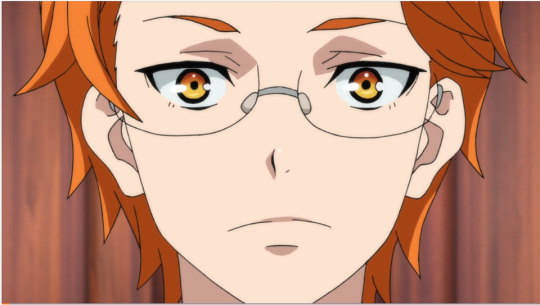
My favorite feature of Kakeru has always been his eyes....
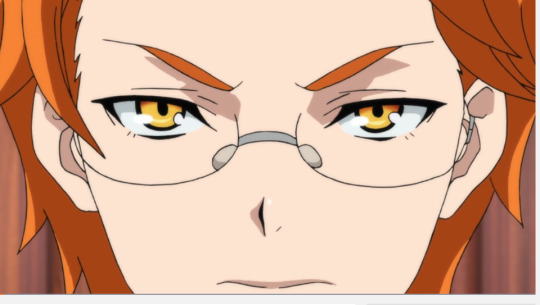
So seeing him go through 8 stages of acceptance in this opening always gives me chills....
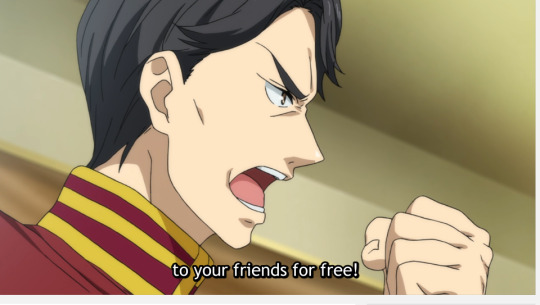
OH MY FUCKING G..............
So in the past I have railed on Crunchyroll for their wonky wording, but this is the first outright mistranslation I think. (Unless “solid style” wasn’t on purpose, but that one was so ridiculous I kinda feel like it may have been....)
If you have seen Pride the Hero, you’ll know Kakeru doesn’t leak the Prism System to his friends. He leaks it to the Itsutomo Group.
To be fair Sadana doesn’t say Itsutomo Group here. Just Itsutomo. But still, what did the translator think the “Itsu” part meant? They leave so many things as-is, but this... THIS they decide to attempt to translate into something.
Okay. OKAY...................................
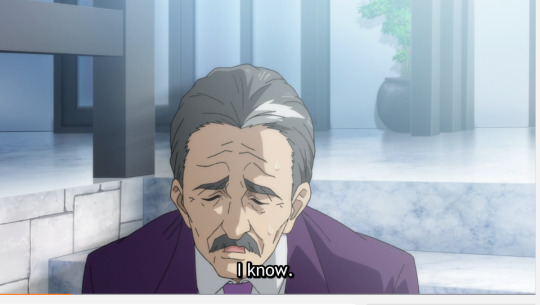
I really, really like Kakeru’s dad. But not for anything he does in the movies/anime. He’s a super boring pushover here. But if you take Young of Prism and layer it on top of all that..... he’s fucking great.
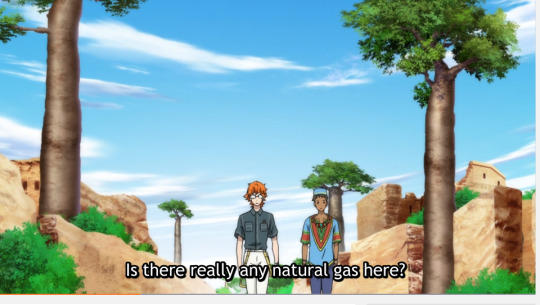
I was so out of it when I first saw this the entire natural gas plot went over my head. I was just like “Episode 5: Kakeru goes to Madagascar. Does a prism show. Then he comes back for some reason. The end?????”
I also missed the earlier reference as well. To think when Kakeru looks at the newspaper in episode 1 and is like “Natural gas is expensive!!” that was foreshadowing ahah.
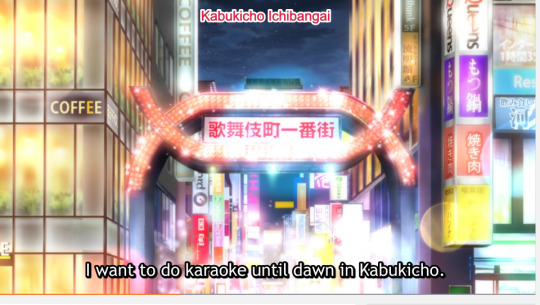
So this is the most controversial part of the episode I think. Globalization/colonization/industrialism has done damage lot of nations which were just fine beforehand, and I think paving over all of Africa’s natural habitats would likely cause.... various problems.
Do I really have any right to be commentating on this? No. But I don’t think King of Prism does either. I just don’t think it’s really the time/place for it.
But all-in-all I suppose Merina’s opinion isn’t too unusual for someone who works for Juuouin Group. I just wish they made it more clearer that his opinion and not the general opinion of Madagascar.
But then again what do I know. I really don’t even want to be talking about this!! It was just such a weird choice to take this episode to Madagascar at all.
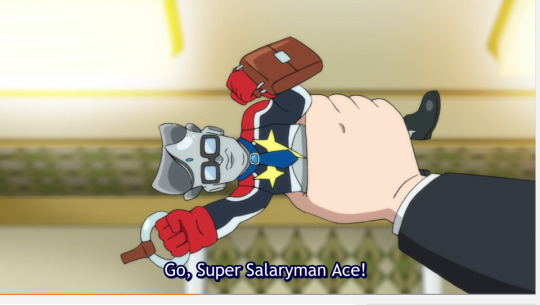
This brought me so much joy. Please go read Young of Prism if you haven’t yet.
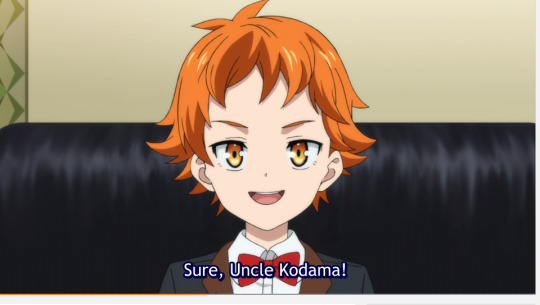
NNghkdhgkdhg baby Kakeru................. face......... uuuUUUgfh and his cute little voice...........
I also often wonder what Kakeru was doing in Kodama’s office in the first place. He’s not actually his uncle I believe.
My headcanon is that his mother dropped him off there one day when she was busy with something and needed someone to watch him quickly, then Kodama-san’s office just gradually became Kakeru’s daycare.
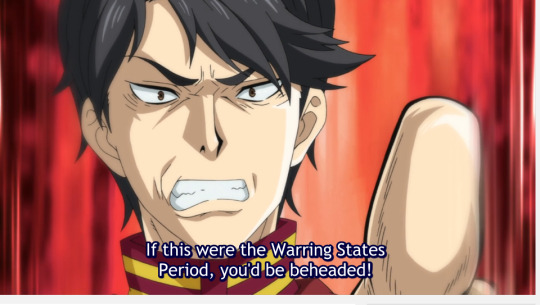
In cheering people will point up one concert light shaking with increasing intensity. Usually orange because nobody knows what other color to use.
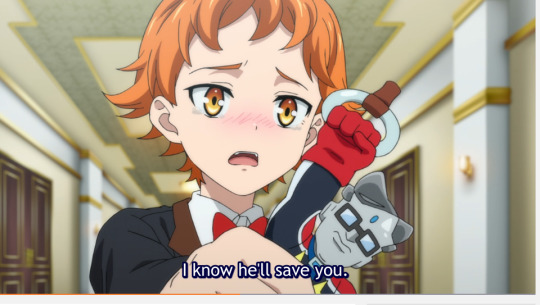
.......GGDGDGDGdksl;fl;sgs.......... AHHHHHHHHHH.....HHH........hhhhhhhhh.. K.....
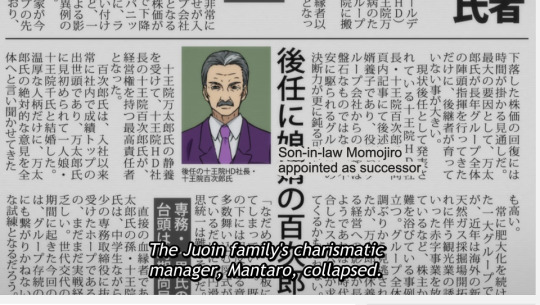
Crunchyroll agrees with me that Kakeru’s father is “Momojiro”. I know that’s the most likely reading, I’m just really bothered and concerned that there is just no furigana for it anywhere.
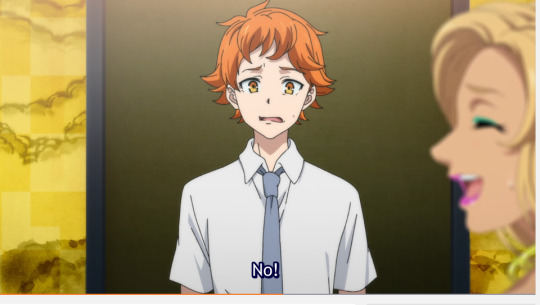
And behold, my favorite Kakeru face of all time.
ahhhhhhhhhhhhhhhhhh poor baby you were so pure back then
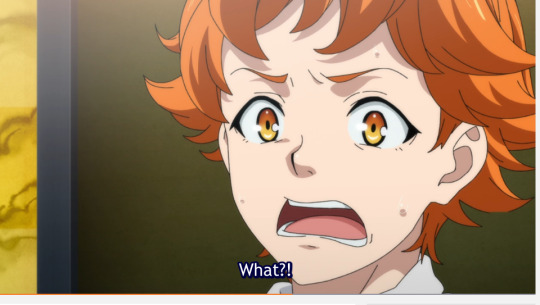
And behold my second favorite Kakeru face of all time aahaha
Okay now is as good a time as ever to bring it up, but.
I’m a bit disappointed that young Kakeru doesn’t wear glasses.
Because most kids get glasses before middle school if they are going to get them, don’t they? It makes me worry Kakeru’s glasses are just an image thing.
I mean he’s certainly frikkin adorable without them, but I dunno.... It made me weirdly happy to learn that Hiro wears contacts in episode 1.
I just want visually impaired comrades in my anime I guess!!!
Or maybe he just went without for longer than he should have by memorizing the eye test by listening to the kid in front of him like I did.
Kakeru can you see I’m worried about you.
Okay I’ll move on......
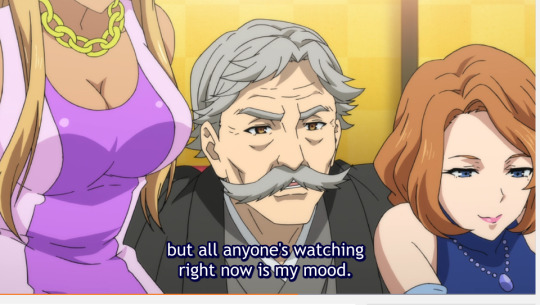
So someone pointed this out in the stream, but he doesn’t really say “mood” here. He says “kao iro” which would translate more into like... health? I don’t know. I honestly have no idea what he was getting at and it’s always puzzled me.
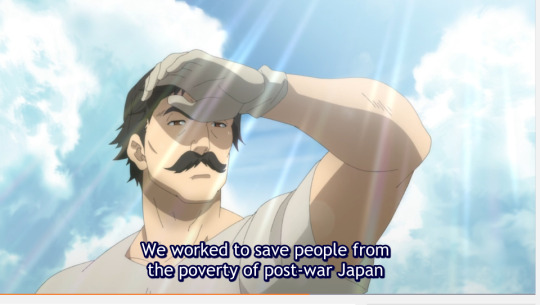
Oh the controversy.....
Okay so, that whole non-issue aside. About the rest of this scene.
I am not particularly offended by it for two reasons.
First...
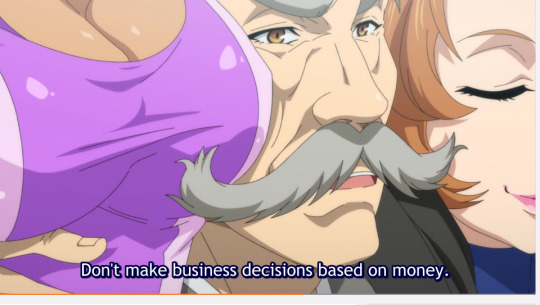
Kakeru’s grandfather is giving him important life advice while his face is IN A BOOB
YOU CANT TAKE THIS SHIT SERIOUSLY COME ON
King of Prism has a tenancy to pair serious moments with ridiculous visuals that nearly ruin them on purpose and it’s a whole other level of humor ahah. There is an even better example of this in the next episode.......
Secondly...
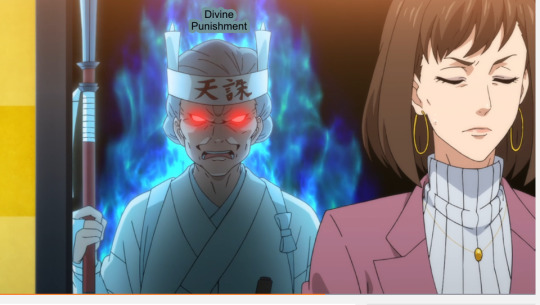
KEI-CHAAAAAAAAAAAAAAAAAAAAAAN
In the theater people hold up two light blue lights as soon as she rises up and then go nuts. It’s the best.
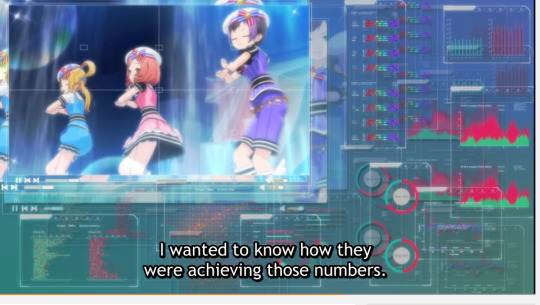
While most of the other characters were inspired by watching male prism stars like Hijiri or Rei, Kakeru watched mostly the girls and I get a kick out of that. We have already known he’s their fan for a while due to his Blowin’ in the Mind ringtone and side materials saying he has their magazines in his room, etc.
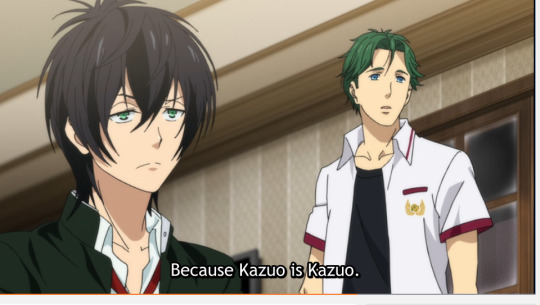
“What” - cheering audience
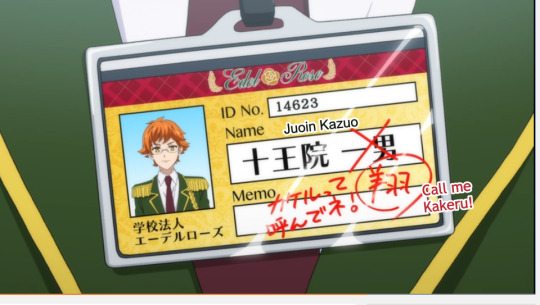
So if you look up “kakeru” in a Japanese-English dictionary, you’ll know it has.... a lot of meanings. And since they always write the boys’ names in katakana (to make it ambiguous I guess) you can never know for sure.
Here we confirmed for the first time it is intended to be 翔 = to fly/soar
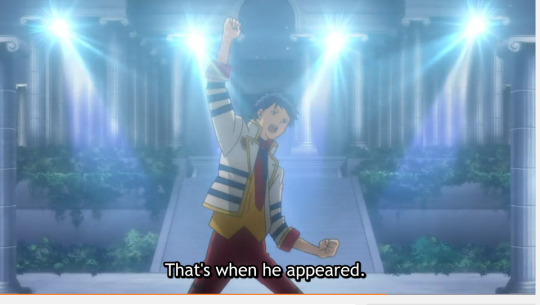
This is a theme throughout SSS. How much Shin changed things for everyone............(I’ll come back to this)............
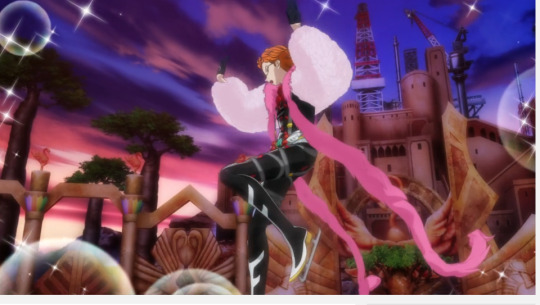
LOVE
So I guess when Kakeru got back from Madagascar Leo was like “So what do you want for your Prism One outfit?” and he was like “Make me a flamingo” and Leo was like “......You got it.”
Or maybe Leo was already like half done with Kakeru’s outfit and then he just burst in the door like “LEO I NEED TO BE A FLAMINGO--”
I only have one bad thing to say about Kakeru’s prism show and it has nothing to do with Kakeru’s prism show. I noticed that his legwork is really similar to Taiga’s, which was when I realized for the first time that it’s the same person doing all the motion capture. So that kind of brought me back to reality a little bit. But oh well. That person is really fucking talented.
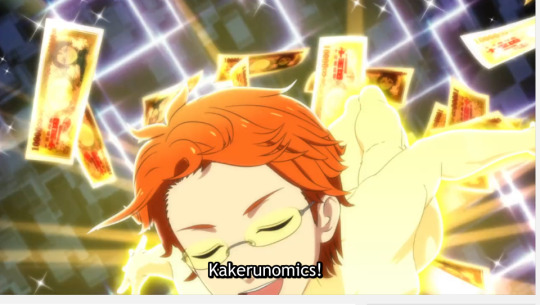
They have been talking about Kakeru doing a prism jump where he’s naked with a pile of money for YEARS. HE DID IT. I’ve seen it in manga, I’ve seen it on Prism Rush... BUT THIS
Also how similar this is to the Prism Rush version amazes me...
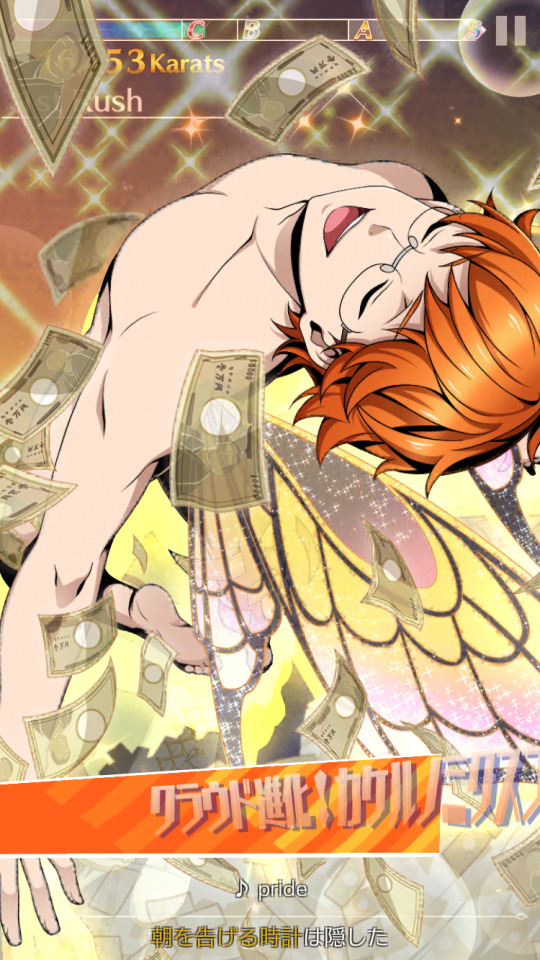
CYALUME CH--
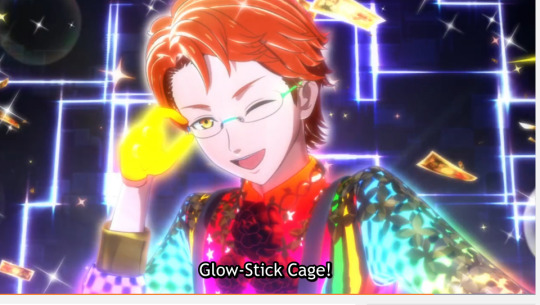
.....So I guess the translators haven’t watched PriPara either huh.
Wait is this even supposed to be for “Cyalume Change” because the subtitle is at such weird timing.
Also I felt bad afterwards about putting “CYALUME CHANGE” as one of my shitty out of context spoilers ahah. I hope I didn’t ruin it for anyone. At least I didn’t say what episode it was. My hope is that anyone who read it has been waiting to be blindsided by CYALUME CHANGE and it came at the best possible moment.
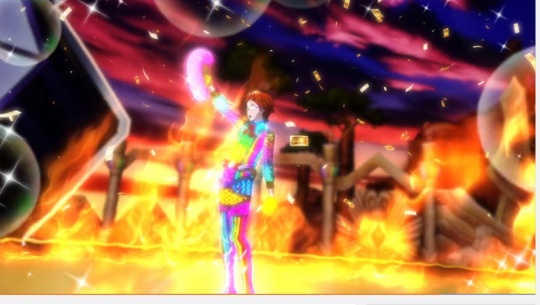
The first couple times I saw this episode I really wondered how cheering would go since so much of this episode is just business mumbo jumbo and if a lot of people would even show up for Part 2 cheering at all.
But then after about a week in I found myself waiting in the lobby before a sold out cheering show and saw a girl whip out a giant pink feathery fan.
Then the girl next to her was like hold my beer and took out a giant (fake) money fan.
Never underestimate Kakeru fangirls is a lesson I have learned over and over and over again.
A lot of people will also have three or four pink concert lights in one hand and an orange one or a color changing one in the other for this part ahah.
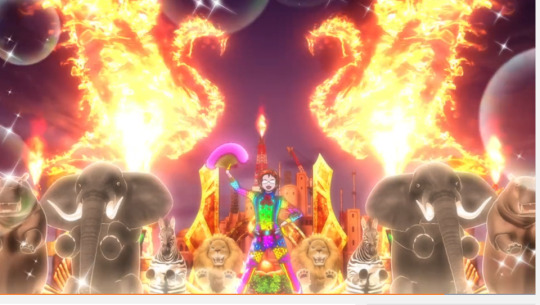
PAINT IT ORANGE PAINT IT ORANGE
(The lyrics to this song are nonsense. But it’s Kakeru, you can’t expect anything less.)
Prism shows with jungle animals are always a good time. (I can’t help but think of Shi Yoon.)
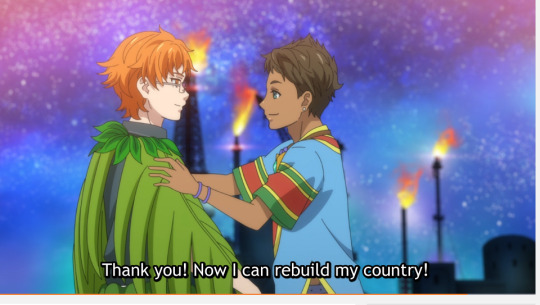
And there you have it, Kakeru saved the entire country of Madagascar.... with his prism show........ let’s not..... let’s not think too hard about this........
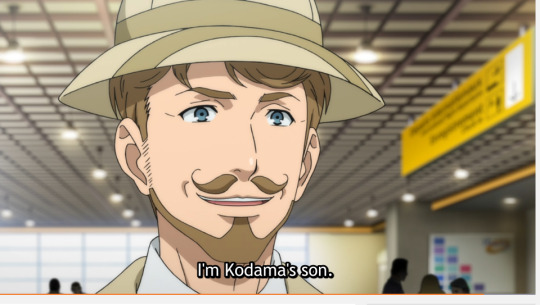
I suppose there are multiple ways this could be true so I shouldn’t be thinking too hard about this either. But.
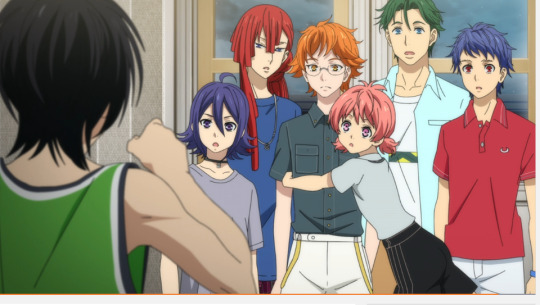
The debut of the Leo pigtails.
Well actually I think he had them earlier in the episode too, but this was the first time I noticed.
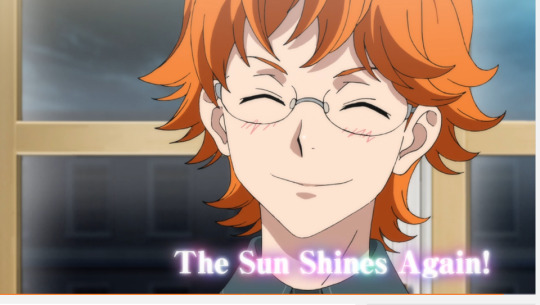
Nothing warms my heart more than the few times Taiga throws Kakeru a bone by showing him the tiniest bit of affection. Even if it’s tsundere. Look at him. He’s just so happy. Aw Kakeru. Good for you.
I think this moment was kinda ruined by the new ending music though. In the theater it’s more quiet.
So I have always kinda felt like the Part 2 episodes are a bit weak compared with Part 1 and Part 3, but that’s probably a bit unfair considering how I experienced them. All of them grew on me more with time. It was also kind of hard coming down off of Taiga’s episode. After Taiga’s was so high tension I kinda expected the same for Kakeru too, but they went in a totally different direction. It was nothing like I thought it would be.
Before it aired I wondered if it would be about Kakeru trying to decide if spending his life in the Juuouin Group was right for him or not. And he did question it at one point when he was younger, but unless I misinterpreted it this episode was more about him loosing what he had and trying to get it back? He had doubts in his mind at one time about whether love exists, but he already came to believe it does before the events of this episode. So I guess Kakeru really has no doubt in his mind about what he wants for his future. You know, I think I like that better. I worry about him burning out with all the stuff he does, but it really does seem to be his true calling.
I find it rather sad that the Edel Rose boys never found out Kakeru’s backstory though. Instead he shares it with Merina. He couldn’t even tell them he was leaving. But then again, Minato quickly interpreted that it was probably too difficult for him, I’m sure he was right. The other boys seemed to understand and support him regardless. Kakeruuuuuuuuu...............
In side materials it’s kinda of hinted at here and there that Kakeru really wants to be more like Minato. He wants to be someone strong who supports everyone. He also really seems to not want to show any weakness to anyone, especially his friends....? (As I’m typing this I’m thinking back to the White Day event on Prism Rush when he was trying so hard to organize everything while also trying his hardest to hide that he was falling apart......) I guess he picked this up in the business world as well. Because of this I still feel there is a lot to Kakeru we still don’t know.
Well. Since I remembered this time and I liked this one: The special video for this episode that they show in the theaters has a voice over describing Kakeru’s intense schedule on a normal day.
But apparently on weekends he does no work at all. He gets caught up on manga and then plays with his friends. They showed a lot of stills of him hanging out with the Edel Rose boys, but my favorite and the one I remember the most was him playing arcade games with Shin (on a mysteriously PriPara-looking cabinet.... I think it was a fighting game though?)
Also Kakeru has a secret trunk in his room which must never be opened.
30 notes
·
View notes
Text
My Little Pony Re-Watch: Episode 27 & 28 Return of Harmony
* DISCORD!! I’M HOWLING AT THE MOON!! AND SLEEPING IN THE MIDDLE OF A SUMMER AFTERNOON!!!
*Now that that’s out of my system, we have arrived at Season 2! With our first two part adventure, save Equestria story since the very first episode. This is one of the most memorable episodes in the entire series. Another one of those episodes that clicked with viewers and solidified some as official bronies. This may be the toughest one yet to keep to just bullet points, but I’ll do my best.
*It’s weird to me that the way Cheerilee describes Discord makes him sound like a legend rather then a historical figure. Like Nightmare Moon. Maybe they just didn’t want ponies to worry knowing that the embodiment of chaos was one chisel and hammer away from freedom.
*On that note it’s never been quite clear how Discord was freed in the first place. The official explanation is that since Celestia and Luna aren’t the bearers of the Elements anymore, the spell they placed was broken. But that happened a while ago, so it seems weird the statue would crack now. It’s also a running joke in the fandom that the CMCs arguing freed Discord. It could be a combination of the two, I’m just surprised this hasn’t been brought up since. Even as a joke.
*Something that is really nice about this episode is that you see how far the Mane Six have come as a group. Once chaos starts erupting in Ponyville, they rally together like a well oiled machine to quell it the best the can. And once Discord officially challenges them, they stay confident in their abilities. It’s a great demonstration of their progression.
*You can also tell the animators and the rest of the crew had way too much fun with the episode. Chaos and disharmony means anything is a go! Cotton candy clouds. Chocolate milk rain (insert obvious joke here). Soap roads. Cottages floating in the air. Ballet dancing Buffalo. And too much more to list! It’s insanity and a sight to behold in just how bizarre and nonsensical it gets! And there’s even more to the creativity and insanity here, but we’ll get to that later.
*This is where we’re introduced to the stain glass windows in the palace. Depicting important events in Equestrian history (though I’ve noticed that a certain banishment isn’t depicted anywhere.....) This is a visual device I always liked and I’m sad the show seems to have abandoned them in later seasons. I’d love to see fanart of later season finales depicted in the glass window style. So if anyone knows about someone who does it, feel free to let me know.
*As I mentioned, this is where we learn that Celestia and Luna can’t use the Elements anymore because the Mane Six are now their bearers. This adds a bit more credibility against the common complaint that the Mane Six are the only ones who are capable of stopping incoming threats. It’s not that they are the only ones capable. They just took action at the right time, and became bonded to the ancient relics that now embody the best of themselves.
*Speaking of which where is Luna? How come i don’t see more people ask about that??
*One of my favorite things My Little Pony related to watch is reaction videos to this episode, and watching people freak out when they realize Discord is played by John De Lancie. Depending on who you get, it is freaking priceless! But for context I had no idea who De Lancie was. In fact the first episode of Star Trek I ever saw was a TNG episode with him in it because I wanted to know what all the fuss was about.
*But i can also vouch that Discord works exceptionally as a character even if you don’t know his inspiration. It’s no wonder that Discord became an instant fan favorite. Jahn De Lancie gives an incredibly memorable performance, his design is distinct and represents his chaotic nature perfectly, and I’d argue he was the most challenging villain the girls have faced in the series (but we’ve still got one more season to go so that could change)
*What made Discord such a great villain was not only how powerful he was, with obvious inspiration from his Star Trek counterpart, right down to him snapping his fingers and his magic often accompanied by a white flash, not only how much he absolutely reveled in the chaos he created with almost every movement, but how he manipulated the girls. Taking away what made them such strong friends without them even realizing it.
*The Mane Six being “discorded” as it would later be dubbed by fans, is a brilliant way to subdue the threat they present, without an obvious way to fix it. Seeing the girls be change into their exact obvious is eerie, disturbing, and kind of heartbreaking. But is also pretty funny at just how far it can go.
*It even comes with this great visual of the girls slowly losing their color and turning gray. This would become an iconic visual cue for fanworks. When i saw it it kind of reminded me of that episode of the Powerpuff Girls where the color is drained from Townsville. Which freaked me out as a kid, so this visual reminding me of that only added to the foreboding situation they were in.
*Rarity’s generosity being turned to greed is probably where most of the laughs come from. Especially with her infatuation with Tom the Boulder. Convinced it’s a diamond.
*Everypony sort of gets manipulated and talked into falling for Discord’s spell. Praying on insecurities. Except for Fluttershy! Who’s so accepting of her flaws that she can’t be manipulated! Discord ends up doing it by force, which is kind of funny, but I am so proud of Fluttershy not giving into to the Lord of Chaos’ words. But I’m sure that won’t be important in the future.
*Twilight makes it through the maze without getting Discorded and still with the hope that they can save the day. Despite how much her friends new attitudes are aggravating her.
*But I do get a kick out of the fact that Twilight accuses Discord of not playing fair. No duh he’s not playing fair Twi. He’s the villain!! That’s not his job!
*Rarity with Tom is a joke that manages not to get old, but why they don’t use their magic to move that boulder once they get their horns back is anypony’s guess.
*I don’t know if we’ve reached the point of saying “this happened in a My Little Pony” cartoon, but i doubt any of the other generations had the main characters and closest friends beating each other up fighting over a book.
*Twilight dubbing Spike the new Rainbow Dash will never not be funny!
*Can we talk about the sound mixing real quick? Not only does this episode have this great memorable score, feeling just as “off” as the rest of the events, but I think they had just as much fun adding the sound effects as they did with the animation. From Discord’s claps all having different weird sound effects, to Pinkie’s bounce while she Discorded sounding like a broken spring. It’s details like that that really sell the fact that nothing is how it’s supposed to be
*In a way, Twilight endurance and frustration during all of this is kind of a role reversal from the first episode. Think about it, if the others had been brainwashed then, she would have instantly ditched them to solve the problem herself. But this time, she knows the best way to stop Discord is together with her friends. But when the Elements don’t work like last time, and she realizes they can’t do it together, she gives up.
*And the moment where Twilight turns gray and sheds a tear in the shape of a broken heart?! Augh! Right in the chest! It’s one of those moments in an animated show where you are sure thing are going to be fine by the end, given the kind of show it is, but it keeps you wrapped in the moment long enough to feel what Twilight is feeling. That this situation is hopeless. And if you ask me, that’s what counts.
*I really love the way Twilight comes around. With Celestia sending all of the friendship letters she’s written over the last season back to here. Reminding her of why she believes in the magic of friendship so much, and reigniting that spark she found back during the battle with Nightmare Moon. This might have been a bit more impactful if this was the season finale like it was originally planned to, but it’s still very meaningful and triumphant.
*But poor Spike having to belch all of those letters out. I felt so bad for the little guy. He may have been left out of the main action again, but he may have made the greatest sacrifice of all.
*So Big Mac’s Discorded self is, a dog? I have no idea what that says about his true self, but okay.
*Twilight helping all of the others remember who they really are is a great solution. Part of me wishes we could have seen all of their memory flashes, like with Applejack, as a way to look back on how far they’ve all come and what they’ve all learned together. But then i guess we wouldn’t have the chase scene to get Rainbow back, so it’s a decent trade off.
*And I like the role reversal of the fact that they helped Twilight discover the magic of friendship in the first episode, and now she’s doing the same for them by reminding them of that friendship. It really feels like things have come full circle.
*An awesome final stand off with Discord, reinforced by probably my favorite message in one of these two parts. That friendship isn’t always easy and has rough patches. But it’s something special and powerful and always worth fighting for. Solidified as Discord TASTES THE RAINBOW as he’s turned back to stone. I’m sure he won’t be back.
I think it goes without saying that this episode is AMAZING!! Introducing one of the shows best characters IMO. Brilliantly executed and full of laughs, suspense, and some of the greatest hurdles and challenges the Mane Six have ever faced. And it made the triumph all the more satisfying. I don’t know what else I can say but this set a really high bar for the rest of Season 2. Next Time: Lesson Zero!
#My Little Pony#MLP Rewatch Marathon!#return of harmony#My Little Pony Friendship is Magic Review#analysis#MLP:FiM
3 notes
·
View notes
Text
On Art Museums and Irrational Fears
Needles, public speaking, oblivion, and visual art are my greatest fears. Not one is scarier than the other, on a scale of one to ten they are all a ten. They are rotated through in each moment when my demise seems most imminent. When I visit the doctor’s office and I’m told I’m going to need bloodwork done, needles go to the top of my list. Seconds before I have to give a speech or a presentation, I realize just how important the opinions are of thirty people I barely know. Oblivion is inevitable, in life, in work, in art, and I think nothing is quite as beautiful or significant if we aren’t constantly fearing it. As for visual art, well... as I stood outside the Chicago Art Institute a few weeks back, I debated my fear once again before taking a deep breath and walking in. I feel emotionally impaired when looking at things I can’t comprehend. Especially, when those things don’t abide by the rules of logic and fact. Art, for example-- the really good kind, the kind that makes you go creating answers for unanswerable questions--is downright one of the most terrifying things I know. But it’s also the reason that if I’m given the opportunity to look at something that scares me, I will skip a Field Museum or the Adler Planetarium and go to the place with the thing I fear most. Okay, weird way to start an essay, but since this is a paper on curiosity and I'm curious: Why did you decide to bite the bullet on this one and go look at art if it freaks you out so much? And the answer to that is perspective. One thing more frightening than maybe all my stupid fears is this idea I’m trapped in seeing things one way. There’s a great quote in the film Dead Poets Society where John Keating (Robin Williams) says, “I stand upon my desk to remind myself that we must constantly look at things in a different way.” Because as artists it’s true. It’s far too easy to settle into a style. We find our voice, we write in it, live by it and bleed for it, creating something entirely our own in doing so. But I think the reason lots of art students never become "artists" is that we allow ourselves to put that final nail in our coffin the moment we stop trying to find new ways of seeing the world. Because with finding our voice we also find a formula to a momentary success, which is the worlds cheapest drug and shortest high. If we use it too much, we become dependent on our own opinions, drain ourselves of all our blood and we will start to question the point of what we’re doing. Without ever trying to gain a new perspective of the world around us, we’ve allowed ourselves to be consumed by oblivion. So I force myself to do things like take surrealism classes, continuously watch avant-garde films and occasionally make an ass out of myself by going to an art museum. Not so I can go drink wine when I’m older and act as a museum tour guide for people at parties, telling them everything they couldn’t see by reading the caption on the side of a painting, but to challenge my own perspective by indulging my fear and fascination. After wandering around for a while, I decided to go look at the Impressionists. None of the art in the exhibit seemed so abstract I couldn’t understand what I was looking at it, but it also wasn’t something that I could definitely say, “That’s what that’s supposed to mean.” Impressionism is perfect because “it’s an artistic style that seeks to capture a feeling or experience through the shifting effect of light and color.” It is rough and personal. Good Will Hunting, another fantastic Robin Williams movie, shows this idea in a scene where Sean (Williams) and Will (Matt Damon) are sitting on a park bench talking after Will told Sean that his wife’s painting is “shit.” Understandably Sean isn’t happy by the remark but it leads to a discussion between the two bringing them together, “If I asked you about art, you'd probably give me the skinny on every art book ever written. Michelangelo, you know a lot about him. Life's work, political aspirations, him and the pope, sexual orientations, the whole works, right? But I'll bet you can't tell me what it smells like in the Sistine Chapel. You've never actually stood there and looked up at that beautiful ceiling.”Stephen Asma does a great job of defining this in his piece, 'Monsters on the Brain: An Evolutionary Epistemology of Horror.' “Why does art communicate, explore, and even reprogram values better than science? Because art is a secret language that speaks directly to the limbic system. Art doesn’t just tell us about emotional conflicts or clashes of values, it actually speaks directly to our effective system—bypassing the discursive rationality. Art triggers the emotions in us directly, it doesn’t represent them to us. The story of a novel or a film may be a representation of another place and time, but the emotional content is a direct infection in Tolstoy’s sense ‘powerful art should “infect” the audience with specific emotional content’ it is not a representation of a feeling,” but cognition of that feeling. Jean Claude Monet and Vincent van Gogh were the two artists in the exhibit that stuck out to me the most. In a number of paintings featured (‘Waterloo Bridge’ and ‘Sunlight Effect’), the context of the painting was fairly evident upon looking at it. Meaning and emotion are not in the formal analysis, but the contextual. Who was the person who made it and why? In a Writing and Rhetoric class a few weeks back we discussed how words and images tell a story and how often the two are unbalanced. We were asked to analyze two pieces of work. It wasn’t anything big, the first thing we looked at was Kevin Carter's Pulitzer Prize-winning photograph from Sudan, showing a small child huddled on the ground in the sun, with a vulture looming over her. At first glance, our class described everything we saw at the moment which the photos was taken, slowly working our way out to the unseen questions like, Who is taking the photo? Was this staged? Where are this child’s parents? The further we asked, the more our perspective shifted. We went from artists to concerned observers, to critics of ethics and humanity, people who were sickened by the idea that no one ever found out what happened to that kid. The photographer, Kevin Carter, ended up killing himself from guilt and the overall and underlying lesson of the day was that we no longer knew what to think. The second piece that we looked at was, oddly enough, Vincent Van Gogh's ‘Wheatfield with Crows’ finished in July 1890. Van Gogh had become obsessed with "the immense plain against the hills, boundless as the sea, delicate yellow.” Captivated by the fields in May when the wheat was young and green. The weather worsened in July, and he wrote to a friend that the "vast fields of wheat under troubled skies," adding that he did not "need to go out on (his) way to try and express sadness and extreme loneliness.” This not only plagued the paintings dark and dreary sky but also Van Gough's mind. It was the last painting he did before killing himself. Okay less about fear and more so about perspective, but why? Fear seems like the easiest thing to draw curiosity from, so why does it change our perception and our constantly changing perspective through impressionism and other forms of art?” I think about how I often have no idea what I’ve written until after I’ve written it. I go into writing with an idea before a theme of it all will kind of come together in the end. I guess that's what I'm curious about. How do we go into writing papers or walking around museums with this idea we know what we're talking about only to end up walking out of these places more uncertain than before? Stephen Asma’s article, 'Monsters on the Brain' gives reasoning behind this. “The point is that these emotional responses are not instincts in the sense of pre-wired or genetically engraved responses. The effective systems are ancient in the sense that they have many homologies with nonhuman animals, but in our individual lives they are idiosyncratically assigned and have significant plasticity. Emotional tendencies and values can help us make fast appropriate responses to environmental challenges, but they can also be retrained or re-educated.” How perspective is developed through our impressions coming into something, gaining information, and our immediate reaction through our emotions is something I never considered as a type of curiosity. Walking out of the Art Institute, I realized I still didn’t fully grasp this idea that our lens is not only used in a form of art but as something that can be manipulated through constant change of what we’re told. Learning. And in that aspect, it is a reassuring sign that my fears, however much I don’t like them, are trivial. Because from a different perspective a needle is something you fix things with, in a crowd of people who are too concerned with their own opinions the person grading you is probably the only one listening, art is a delicate balance of pictures and their context, and oblivion is only inevitable so long as you chose not to see it.
1 note
·
View note
Text
Brandon Cronenberg’s Possessor Is Sci-Fi Horror With A Twist
https://ift.tt/eA8V8J
Possessor is the name of the new film from Brandon Cronenberg, who made his feature debut in 2012 with Antiviral. Like that film, Possessor is an unnerving hybrid of sci-fi and horror about the invasion of one’s body by something transplanted from another human being. But while Antiviral focused on a bizarre fan culture in which people injected pathogens harvested from their favorite celebrities, Possessor deals with the ramifications of one person actually taking over the mind of another and controlling all their actions and thoughts.
The movie stars Andrea Riseborough (Mandy) as Tasya Vos, who works for a clandestine company that uses brain implant technology to take over the bodies of others and have them commit assassinations for the benefit of the company and its clients. Sent by her superior (Jennifer Jason Leigh) on her most dangerous mission yet, Vos begins to suffer long-term effects from the process that threaten to send her into a deep psychosis while destabilizing her ability to retain her own identity.
Set not in some distant, gleaming future but an alternate version of 2008, Possessor has much of the clinical observational style and visceral physical horror that were trademarks of the early work of Brandon’s father, the legendary David Cronenberg. But the younger Cronenberg carves out his own path here as well, with characters whose suffering and conflicts are relatable even in the surreal circumstances facing them. We spoke with Brandon Cronenberg about the genesis of the story, its ramifications, and placing it in a world just two steps removed from our own.
Den of Geek: I read that this film was initially inspired by you feeling like you were somebody else in your own body. Was that essentially the experience you were having?
Brandon Cronenberg: In a sense. I was going through a bit of a strange period and this is maybe a very trivial place for a film to come from. But a lot was in flux for me and I was in a sense feeling like I was living someone else’s life. In the morning I was getting up and having to construct some character who could operate in that context, which I think is something that is not completely uncommon. So I wanted to write a film about somebody who may or may not have been an imposter in their own life, and use that as a way to talk about how we build character and narrative as a means of operating as human beings. The seed of the film was really in those dramatic character scenes and the sci-fi thriller elements built out from there.
Did the basic idea change a lot over that time as you were developing it and going through drafts of the script?
Yes, absolutely. Especially because it took quite a while for the film to get off the ground. I kept revisiting the script and tweaking it and changing things as I had new ideas and as I re-read it and wanted to alter it. So it did evolve quite a bit.
It’s been eight years between features for you. Was part of that getting everybody lined up behind it, getting the financing and all the usual trials and tribulations?
Exactly. Especially for an independent film, it can take a while to get it financed. Sometimes it comes together very easily and sometimes it takes a while. This one just happened to take quite a while to put together, not for any particularly interesting or strange reason, but just the usual indie film stuff.
What lessons did you learn from Antiviral that you wanted to apply to doing Possessor?
It’s hard to really specify, but I learned a lot. Obviously, making any film, even a shorter film is a huge learning process. And then to make a feature and deal with the timescale and tracking a narrative over a film of that length, it’s all a growing process. It’s all, especially for someone who is still essentially at the start of their career, it’s all useful stuff. But I can’t really point to one thing that wasn’t a lesson learned. It was all a lesson on a certain level.
Did you have more confidence going in this time?
I don’t recall. It had been a long time between films. I’d made some shorts and some music videos in between, but it felt fairly similar going into it. If there’s a difference, I think it’s that I spent a lot of time working with some of my close collaborators during that development period, like Karim Hussain, my cinematographer, and (producer) Rob Cotterill. So I had a closer-knit group going into it. We had spent a long time working together on it and so it felt good in that way. And actually once we finally did get to shoot the film, it ran quite smoothly.
Getting back to some of the narrative ideas, Vos has that same conflict that I think a lot of people have between work and private life, although hers is taken to an extreme considering the work she does. But was that the key to making her relatable, even though she’s an assassin?
I think it was definitely a part of it. I think her kind of struggle is relatable to a lot of people, not just the contrast between work life and family life. But I think for all of us, we’re dealing with who we are in an internal way, which can be incredibly chaotic and sometimes dark and difficult, and not necessarily something that fits into a civilized, domestic scenario exactly. I mean we’re all apes and we all have a complicated inner life in all this, which we then have to essentially merge with our external characters who are able to function in those kinds of environments. So I think it’s also the conflict between interior sense of self and exterior sense of who people expect her to be and who people see her as. I think that is all somewhat universal.
Did you always start out with the character as a woman?
In a very, very early version of the story as I was mapping it out, Vos was male only because it had come from my own experiences and I guess I just defaulted to male. But the two things that occurred to me very quickly were first of all, it would be more interesting to write a female lead and I had just done a male lead with Antiviral. Having her be a woman who’s in a man’s body adds this additional layer of contrast between the two of them, which I liked. Then also, I think we’ve just seen a number of stories where the man is having a hard time integrating with his family after experiencing something on the job, whether it’s The Hurt Locker or cop movies. We’ve all seen that the father and husband who’s disassociating from his family because he’s seen too much. So it felt a bit clichéd to have Vos be a man.
Neon
Why is it set in an alternate 2008, instead of 2023 or something like that?
The technology in the film is rooted in actual neuroscience. There is science there, it’s not completely a fantasy. But for that technology to actually exist in our world, it would have to be very, very far in the future. But I wasn’t really conceiving of Possessor as predictive science fiction. All the science-fiction elements are meant to be metaphorical and meant to be discussing who we are as human beings now. So I wanted the world to feel more relatable and not be this big distant sci-fi future. So in my mind, I shifted it into an alternate timeline where that technology had developed to the point that it was, and that freed me up to be able to play with it in a figurative way, rather than trying to make it realistic.
Now are there more aspects to this alternate universe that you extrapolated for yourself that we don’t see in the film? For example, the film hints that this is a world where corporations reign even more supreme than they do now, to the point of ordering assassinations.
Certainly. I like films that suggest a bigger world, but don’t spell everything out. I like films where the audience gets to invent for themselves, but in order to make it coherent, I had to, of course, delve deeper into that world-building than was maybe evident on screen. In terms of the corporate world, I mean, there’s interestingly a history of militarized corporations. The Dutch East India Company had its own private army and ruled Indonesia for centuries. Some people consider the Knights Templar to be the first multinational corporation and they were, of course, a Catholic military order to begin with. So I was interested in corporations returning to this place historically where they’re operating a little bit as states or having maybe a Cold War moment with violence happening in the shadows.
Is this a world you would potentially return to? Are there other stories you could tell there?
I would like to. Despite everything I just said about not being explicit with the world, I think it would be fun to flesh it out for sure.
I understand you tried to do as many practical visual effects as possible.
The film is essentially all practical effects. The hallucination sequences are entirely practical. The scenes of violence are almost entirely practical with a little bit of clean up and so on, courtesy of Dan Martin, our makeup effects lead, who is absolutely incredible and a mad genius and allowed us to do things practically that we wouldn’t have been able to otherwise.
What are you working on next?
cnx.cmd.push(function() { cnx({ playerId: "106e33c0-3911-473c-b599-b1426db57530", }).render("0270c398a82f44f49c23c16122516796"); });
I have two films that are fairly far along in the development process. One is called Infinity Pool, which is a tourism/resort satire with sci-fi horror elements. The other is called Dragon, which is a space horror film. Both of them are written and in active development. So depending on how things play out in the next little while, I hope to get back to shooting soon.
Possessor is out in theaters — wherever they are open — on Friday (October 2).
The post Brandon Cronenberg’s Possessor Is Sci-Fi Horror With A Twist appeared first on Den of Geek.
from Den of Geek https://ift.tt/3nf5ZAI
0 notes
Text
[TEXTBOOK REVIEW] Integrated vs. EWHA
In the 5-ish years I’ve been off and on studying Korean, I’ve largely worked with Talk to Me in Korean, Integrated textbooks, and EWHA textbooks. I’ve never felt the need to venture into other textbook series (though I’ve been peeking through and I guess technically working with another since coming to Korea, but only in a sense of review.) Good textbooks differ for person to person - we all learn in our own styles and need things presented to us in different ways.
This system has been invaluable to me. As a self-studying learner, the kind of textbook you use is really important, because most of us don’t have a teacher to correct us or further explain things, and likewise, many of us don’t have a Korean friend or Korean-speaking friend to assist along the way. I’ve been lucky to have friends to help, but still, the textbook I used was very important for this.
Thus, I have a hopefully detailed and terribly picture heavy review of both Integrated and EWHA textbook series and how they compare to each other or how you as a learner can utilize them together or with other books!
When I got my first textbooks, I’d already taught myself to read and write Hangul and had been working quite a while with Talk to Me in Korean. As a result, I was a bad student and skipped a lot of the stuff at the beginning of the textbook. If you’re a new learner: DON’T DO THIS! There’s a lot of invaluable information, especially in the Integrated series. I’ve brought my beginner book to language exchanges before and have swayed a few people into buying some of the books I use because they found the beginning information alone to be hugely beneficial.
My first textbooks were the Beginner Integrated series. My decisions were based on the fact that I already had friends using these books - it would make it easy for me if I had questions, as they’d already worked with these before - and also the price. At the time I got them, I was able to get both Beginner 1 and 2 for about $35. Unfortunately, that was 5-ish years ago and the price isn’t quite as low and is much more on par with other textbooks.
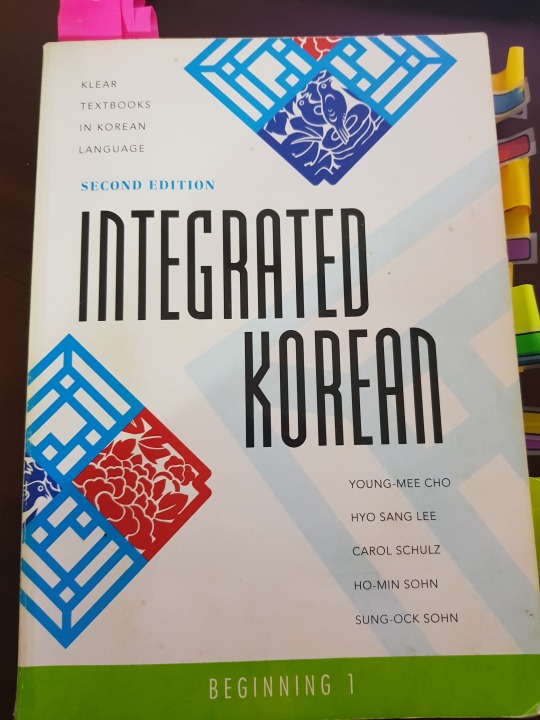
Please don’t mind how old and beaten up looking it is; this guy and I have been through a LOT together!
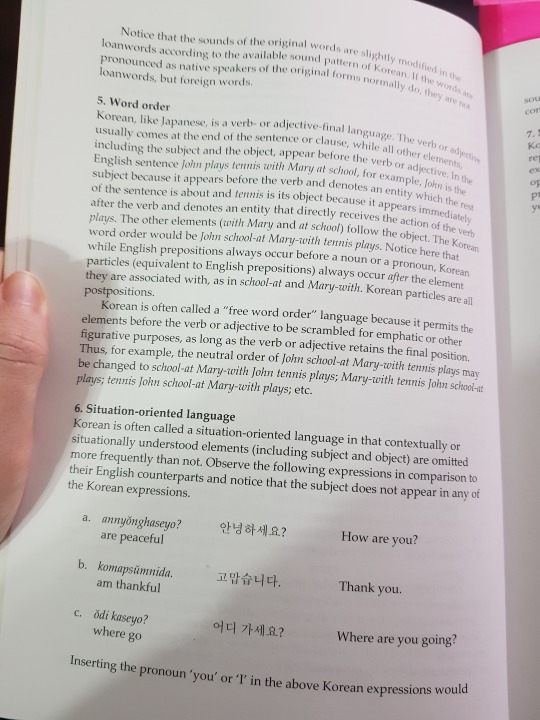
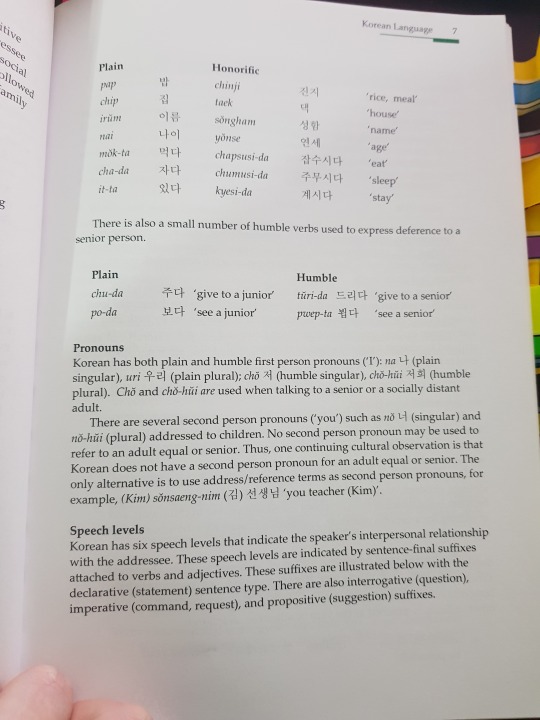
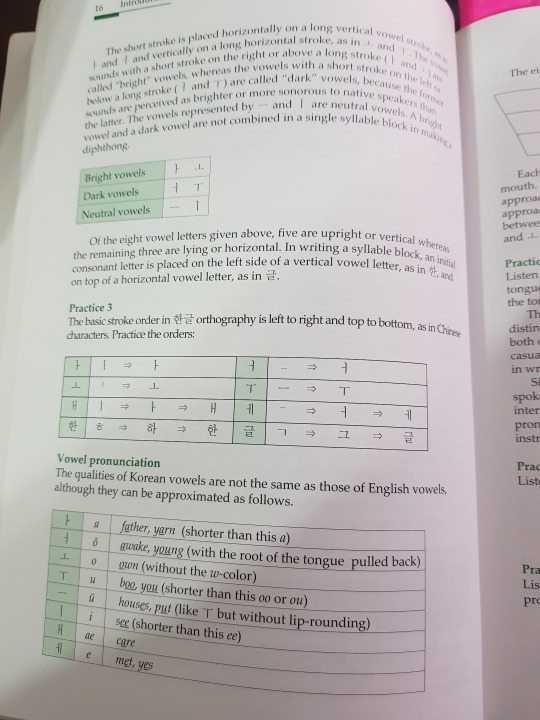
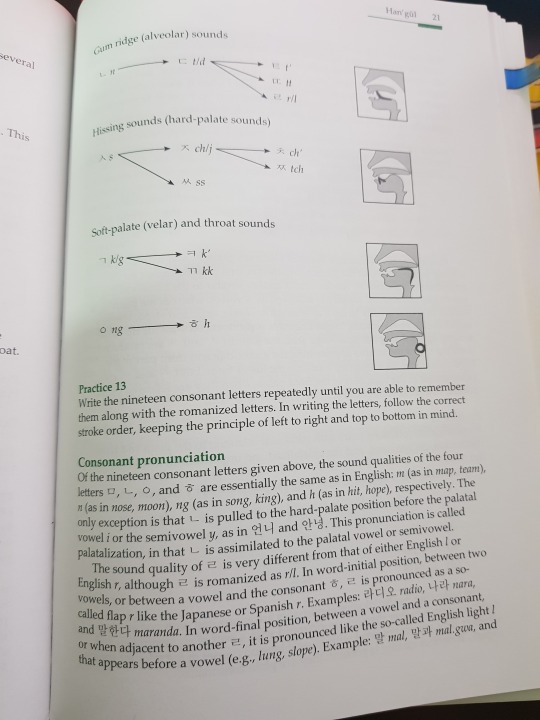
This is the stuff I skipped when I first got the book, and frankly, would have been invaluable to my learning. From the way I taught myself to pronounce Hangul, even these days I still have to push myself to differentiate my 으 from 우. But visually seeing how these sounds are formed is really important, especially for beginners. There’s a lot of sounds we as foreigners and especially as beginners struggle to differentiate. When I help at Diana’s classes, I find a lot of people have issues with 어 and 오 - let alone 에 and 애 and further 스 or 쓰. Of course it’s not a foreigner only thing; at the language exchange, while helping Koreans with pronunciation, I’ve found they sometimes hear things that aren’t there or can’t differentiate certain sounds, either. That’s just language. But knowing how to say things not only helps your pronunciation but when you’re talking to someone, watching the way they speak can help you differentiate sounds as yours ears get used to it.
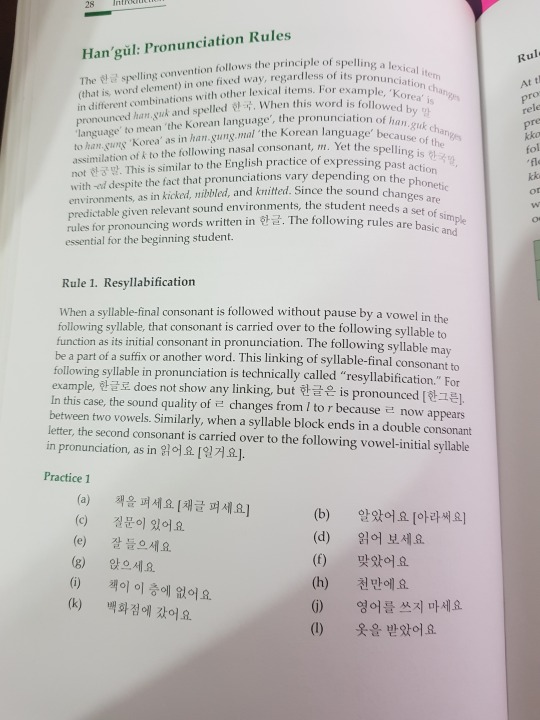
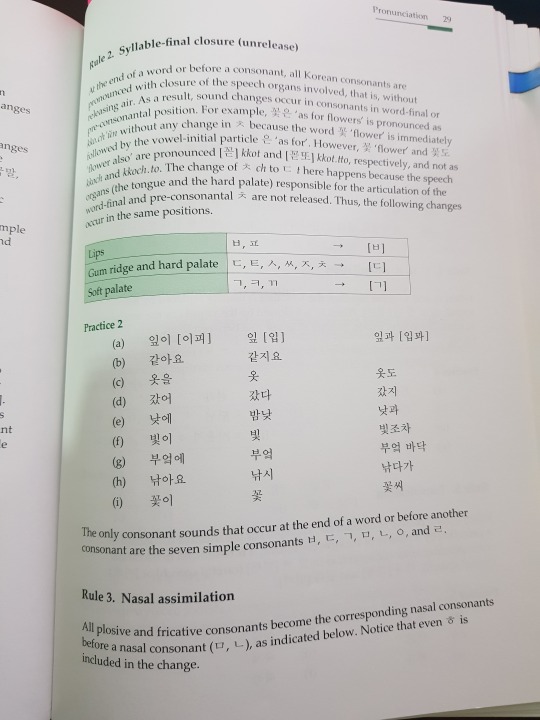
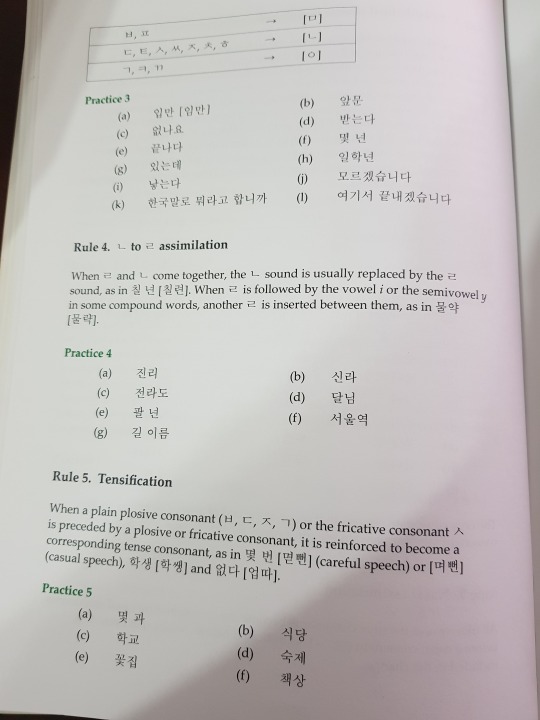
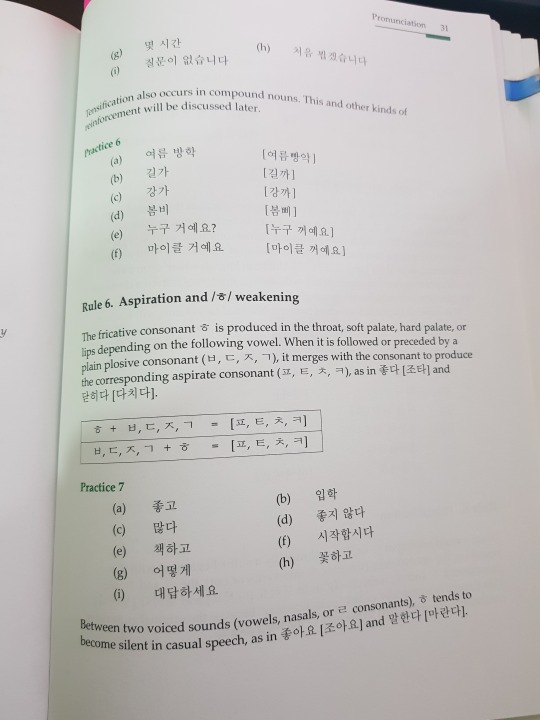
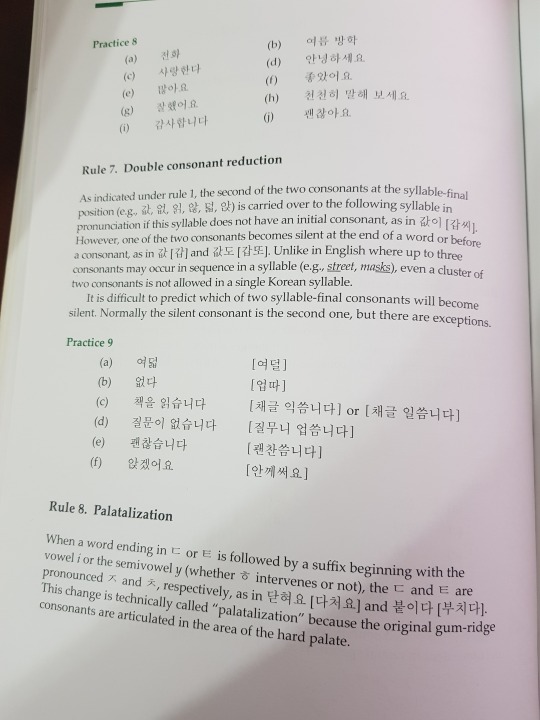
It’s actually quite extensive. Again, if I’d read the beginning, I would have figured out things like resyllablfication - a mouthful that simply means consonants carry over into empty spaces to make pronunciation MUCH easier. Instead, I spent a good while mispronouncing everything and wondering why speaking was so difficult.
Now let’s get into the good stuff!
Integrated is set up into Lessons that are then broken up into 2 conversations/dialogues. After each conversation, you’re given a new word bank, and some new words and expressions in your notes. After that it’s a couple to few pieces of grammar. Sometimes that grammar is a full grammar piece (like a sentence ending), sometimes it’s a particle, sometimes it’s about irregular /ㄹ/ or /ㅡ/ or something.
Typically, integrated is very detailed. There’s usually a lot of notes, examples that show varieties of way of use, and then exercises! I never got a workbook with Integrated so I can’t tell you much about it, but because a. I had no one to check it and b. I have so many exercises in the book, I didn’t regret this. A friend of mine who has used integrated told me that she feels the exercises in the book are sufficient enough because they’re very similar to what you see in the work book anyway.
Let’s have a look!
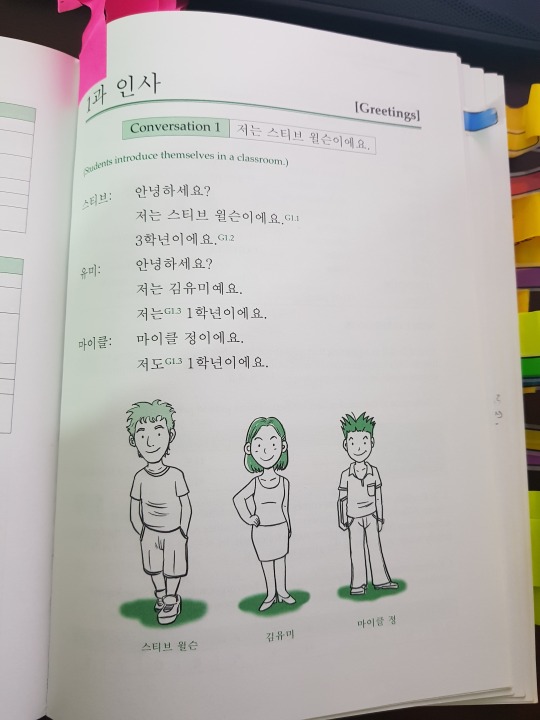
Look how short these dialogues start out. Ahh, nostalgia~
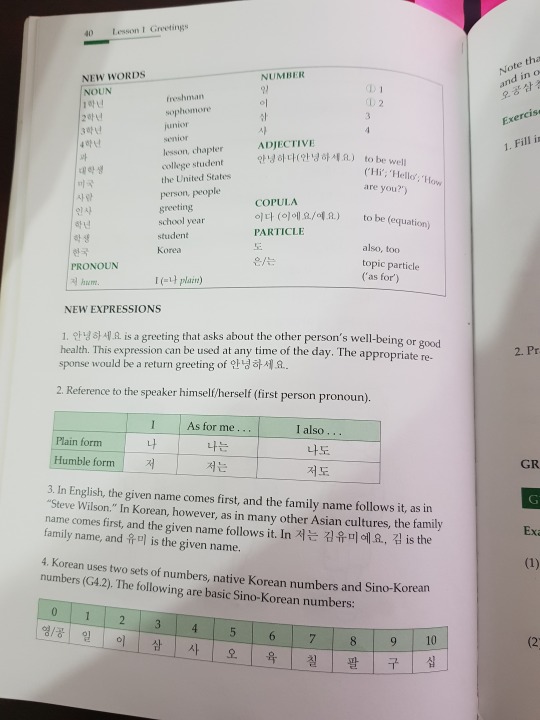
The word bank is always sorted by word type, which becomes useful when you get further in and realize that sometimes adjectives are conjugated differently from verbs! The New expressions heading usually is followed by really useful stuff that doesn’t always warrant its own grammar lesson but still is relevant to your learning.
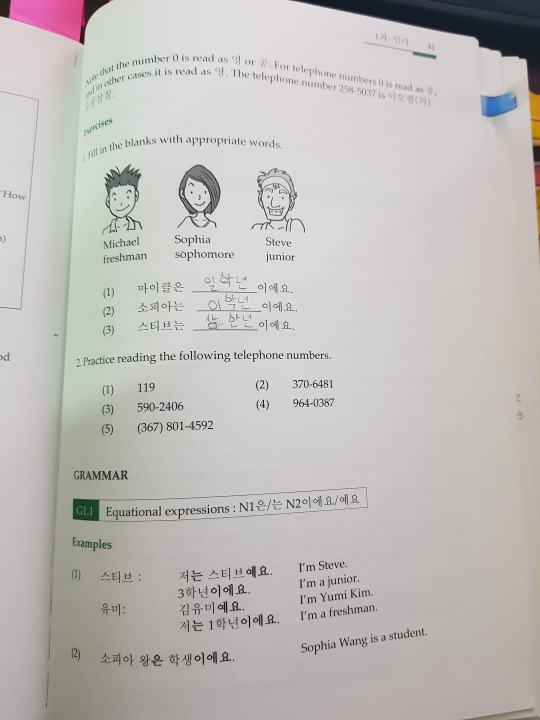
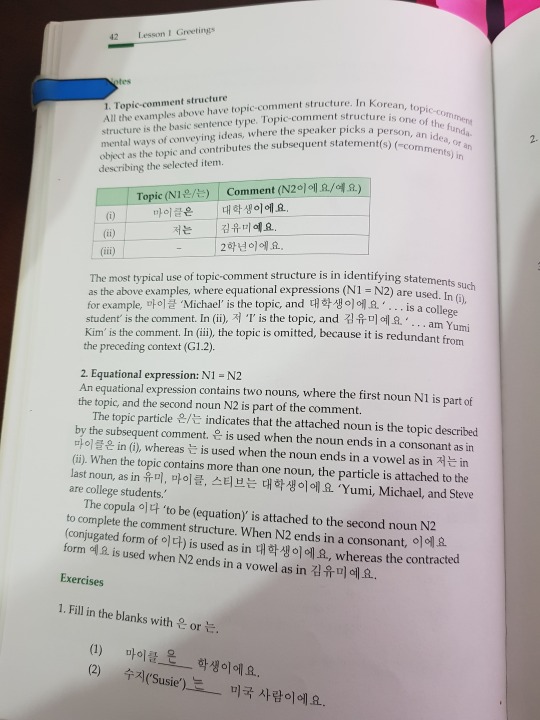
Grammar is always introduced first by examples and then explained in the notes. As you can see, Integrated can be very verbose in its explanations. For some people, this is beneficial. Others, not so much. I tend to like to learn my grammar inside and out; I’m not that great at learning by example or inferring reason, so this very verbose manner of explanation is great for me. Also, I have a tendency to overthink things, so when it’s laid out, it helps.
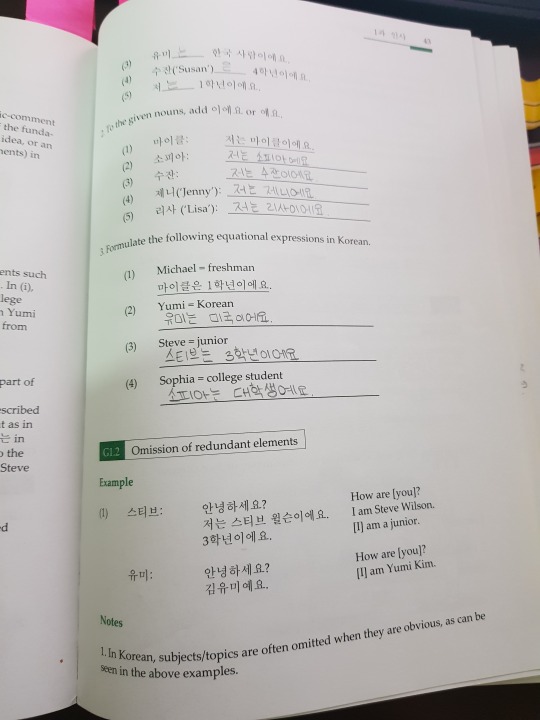
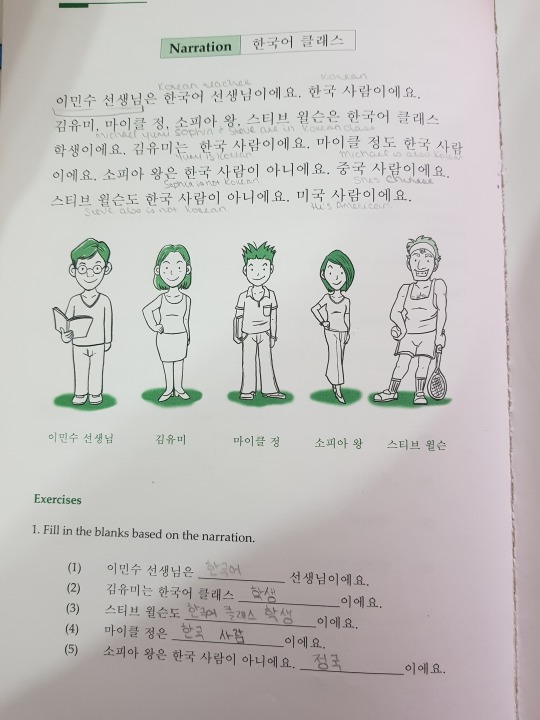
The end of the lesson is always presented with a narration that uses all of the grammar you learned in the past lesson and whatever the lesson’s central theme was (university life, transportation, food, etc.) There’s comprehension questions and activities. But the best part of the end of the lessons is all the stuff they tack on!
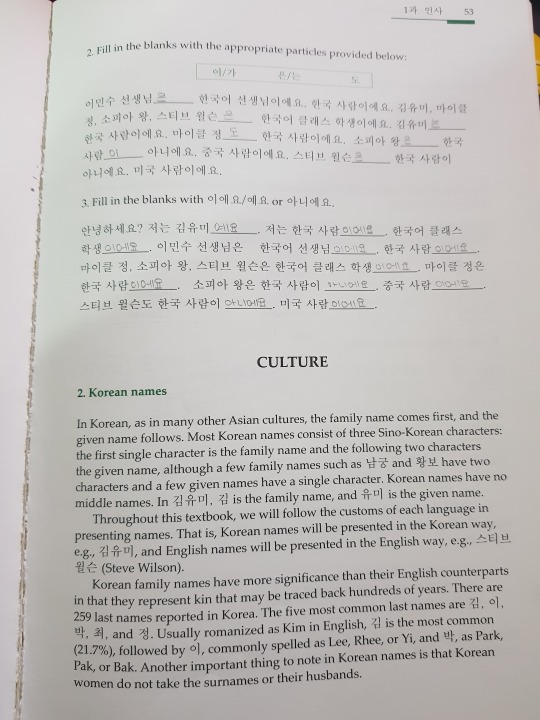
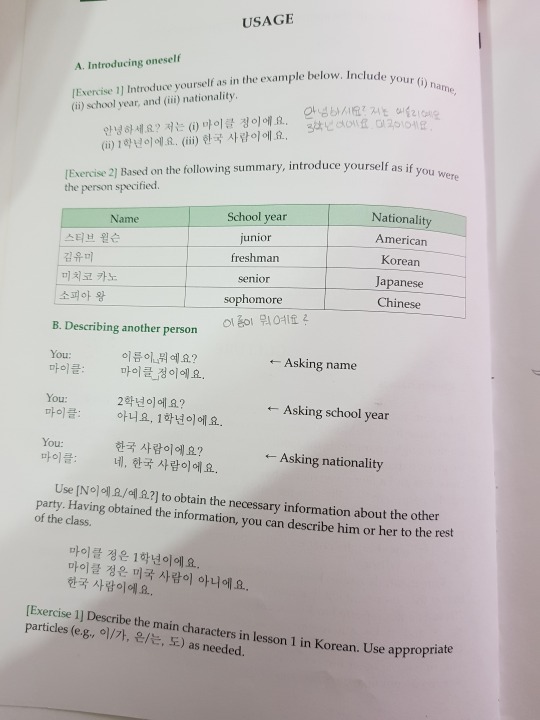
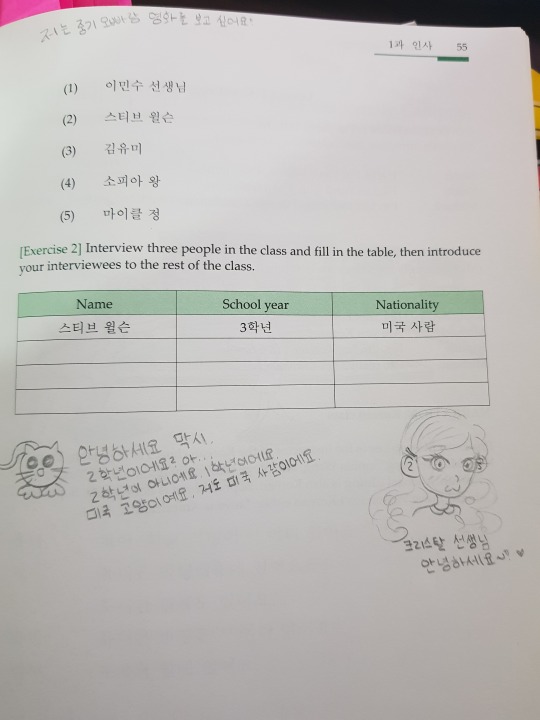
Ignore the doodles, pls. And the notes. I was a mess, okay!
The end of the lesson always features some kind of culture lessons where they teach you various matters about life in Korea and Korean society. It also goes further into detail about usage. Language is not a one way kind of thing. The way initially presented in the textbook is not the only way to say or express things. Further, it has more activities that build upon what you’ve done throughout the lesson. See why a workbook is virtually unnecessary?
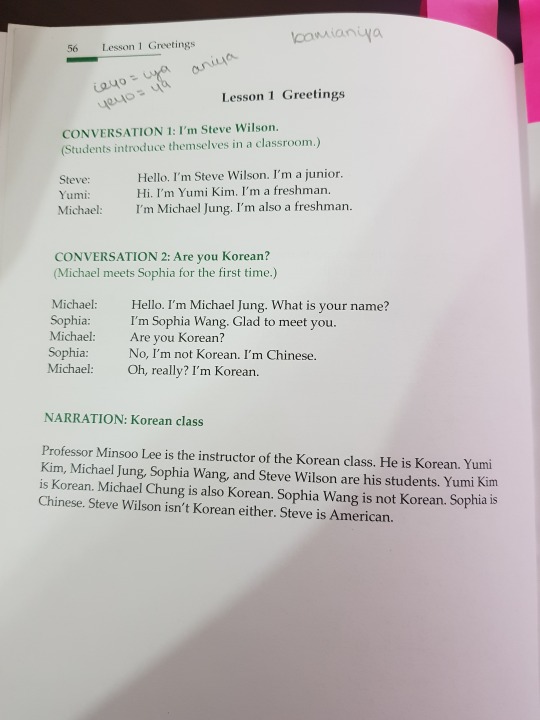
Importantly, the end of the lesson has conversation translations. As you can see, there’s no answers for the exercises, which could be a make or break thing for people. Having no one to correct it makes it hard to utilize the exercises.
Despite the fact that the book lacks answer keys, I find Integrated has been invaluable to my learning. Admittedly, I may be biased because of the time I’ve spent with these books, and thus I’ve grown fond, but even in retrospect I still feel they were and are incredibly useful.
Integrated textbooks are thicker than my EWHA textbooks - they're roughly the size of 2 EWHA books, which seems to make sense because Integrated has two beginner books and I believe for EWHA, level 1 and 2 are considered beginner and 3 seems to start on an intermediate level. As Integrated books are so big, they’re full of information. FULL! The first beginner book alone presents quite a lot of conversational grammar and vocabulary and beginner 2 (what I would think of as high beginner to myself) further expands on it.
Admittedly I was the most inconsistent studier until I came to Korea, so it’s probably unsurprising that I’ve worked out of these two books for the entirety of the time I’ve been learning. In fact I only JUST made it into my Intermediate books. I have a lot of reasons for that, but the point I’m trying to make is that I’ve spent all these years able to use the grammar and vocabulary from these books, so it’s really quite beneficial in my eyes.
(A comparison, for example, is the book my friend teacher Diana uses. Her lessons follow Beautiful Korean, a book that has 3 books in the beginner series, I believe, and each costs 16,000 won. Considerably cheaper, sure, than Integrated Beginner coming in at 30 a piece. But when you consider again that Integrated is the size of 2 textbooks, the price seems to even out. Further, Through us using Beautiful Korean, most of what we learned was only pronunciation and vocab. Only at the beginning of the 1-1 lessons were introductions and the most basic sentences and structures introduced. The actual act of making sentences and grammar doesn’t show up until 1-2. So further, if you consider comparison, you need all 3 books from the beginner series of Beautiful Korean to possibly probably equate to Beginner 1 and maybe 2? idk I haven’t seen what comes after Beautiful Korean 1-3; it might still be beginner level for all I know! That’s not to put down the Beautiful Korean series at all but as far as values, when you consider all 3 books will cost about 48,000 won, Integrated, to me, seems more valuable. But I digress.)
Integrated Beginner 2 stays much the same and follows this same format. In fact, even in Integrated it does, though notably the conversations grow longer and now after each conversation there’s comprehension questions, which is a welcome addition!
That said, EWHA certainly has it’s merits, and my shallow self will admit the fact that they are ever so pretty certainly endears me towards them - but I promise it goes well beyond shallow reasoning.
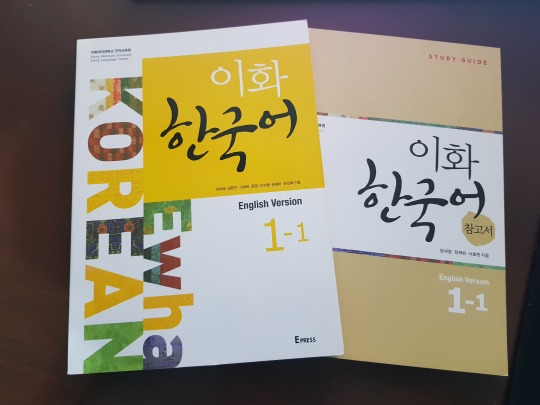
EWHA is best paired as a set with it’s companion study guide. As you will see, EWHA does not go as deeply into explanation about things as Integrated - and thus we have the study guide. Sometimes the study guide doesn’t offer a deeper explanation, either; often it’s unnecessary and as I’ve mentioned before, EWHA seems to want you to understand things through context and by gleaning things yourself. The study guide provides more examples, though, in case an explanation isn’t quite enough; you’re supposed to figure out usage and context with those examples. Sometimes it’s great! It depends on how you learn, to be honest. I find I need lots of examples AND lots of explanation, but I’m trying to learn to mine more from examples without being handheld and spoonfed, but like I said - we all learn in different ways.
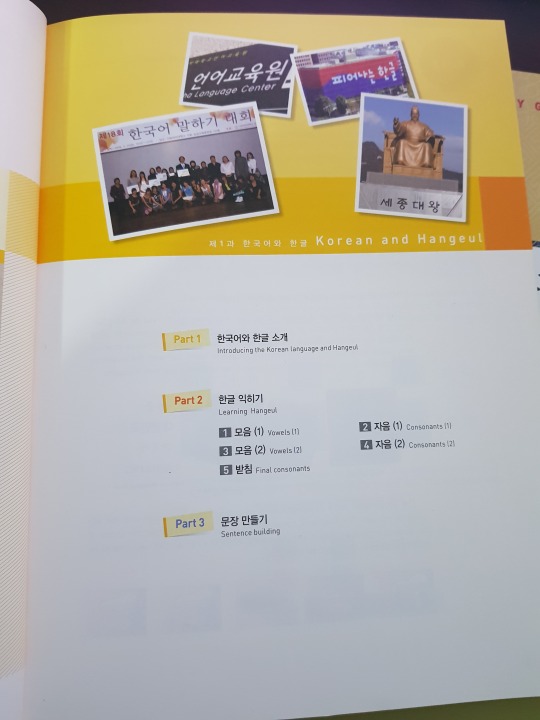
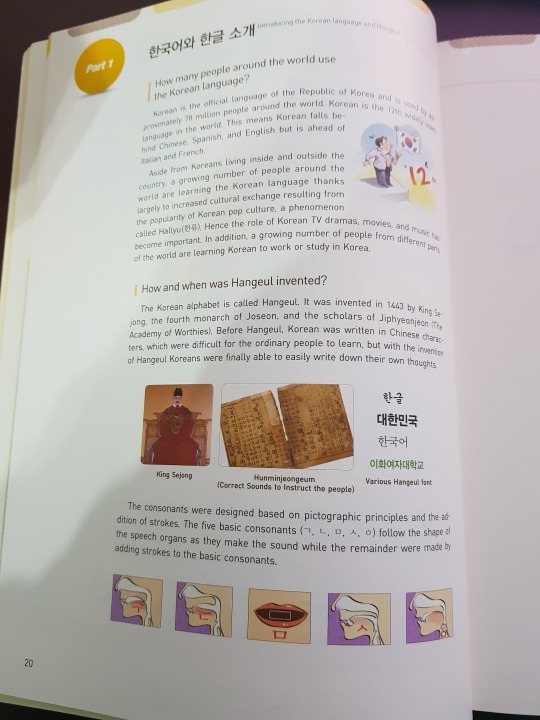
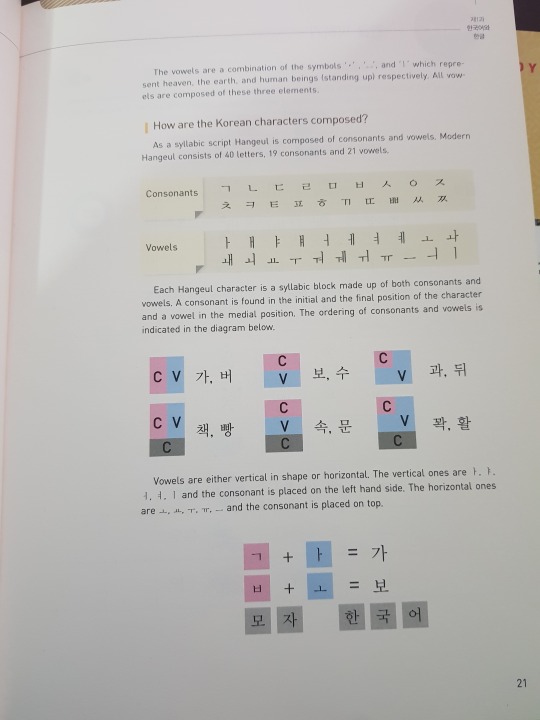
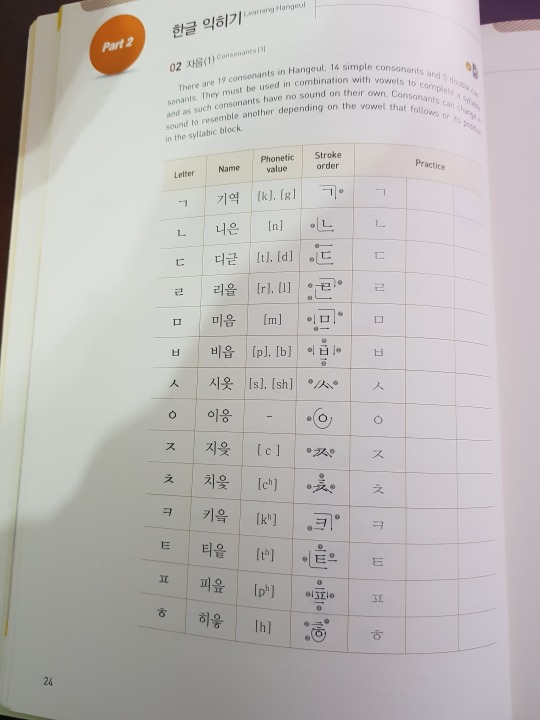
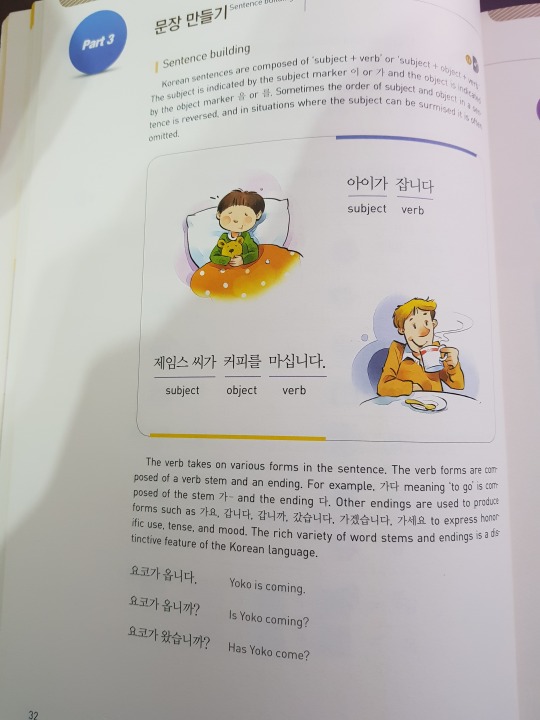
Much as Integrated does, EWHA has a good introduction to Hangeul in both pronunciation and construction. Though I don’t find it QUITE as indepth as Integrated is, EWHA tends to throw little tips at you as you work through the books that Integrated introduces in the beginning, and really you don’t miss much by getting them later.
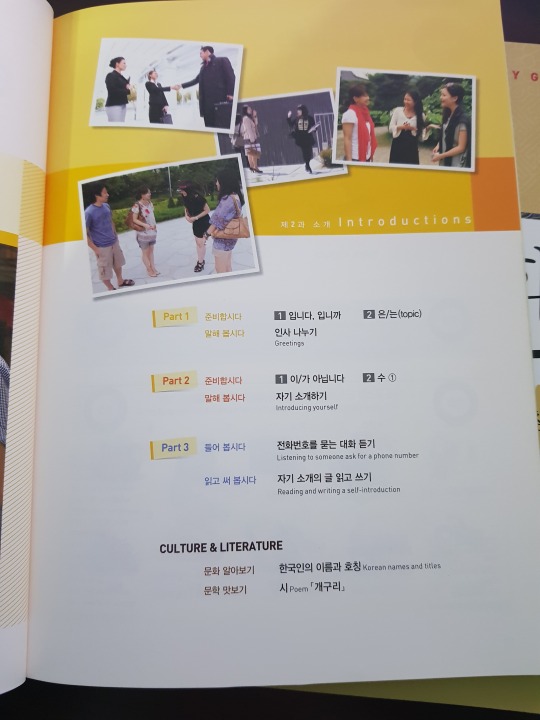
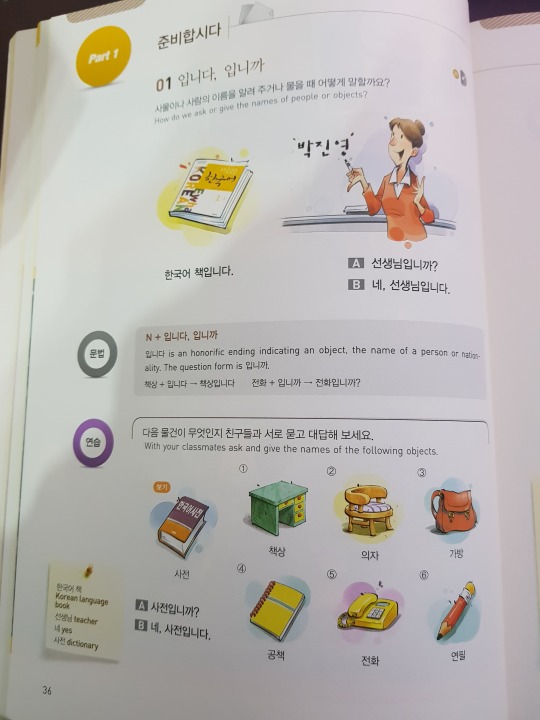
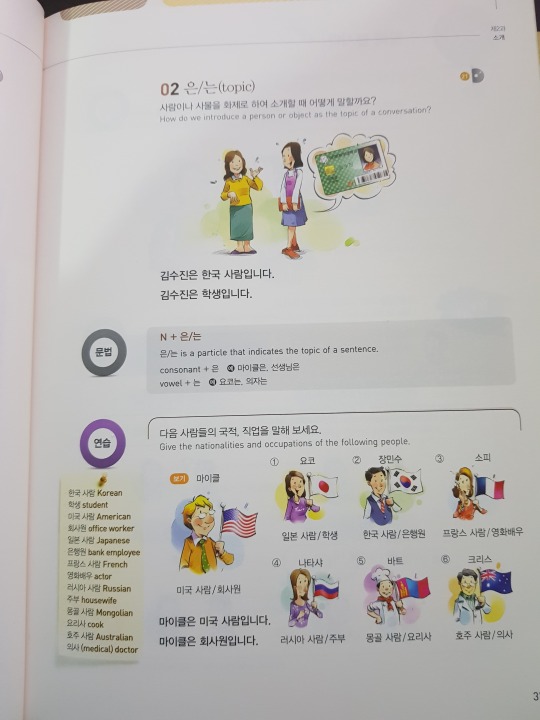
So Integrated is set up in lessons with conversations per lesson. EWHA instead gives you two prep lessons which will lead to a conversation practice. And where Integrated introduces one big word bank per conversation, Integrated just throws them all into your prep lesson. Sometimes it’s big, sometimes it’s small. Something useful that I didn’t do but probably should have was going through the entire lesson and write down the vocab or make flashcards if that’s your thing and review them before you get to them that way they have some familiarity to you. Or, on the other hand, you can go through at the end of the lesson and see which words you remember and then play with the ones you don’t. Your call!
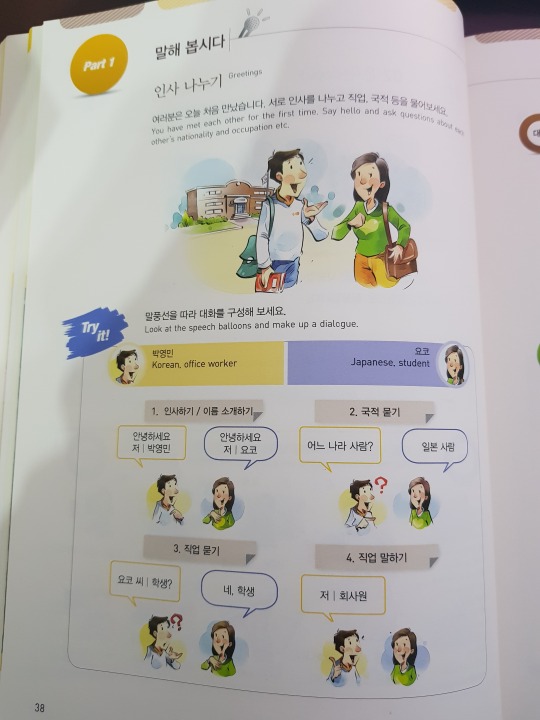
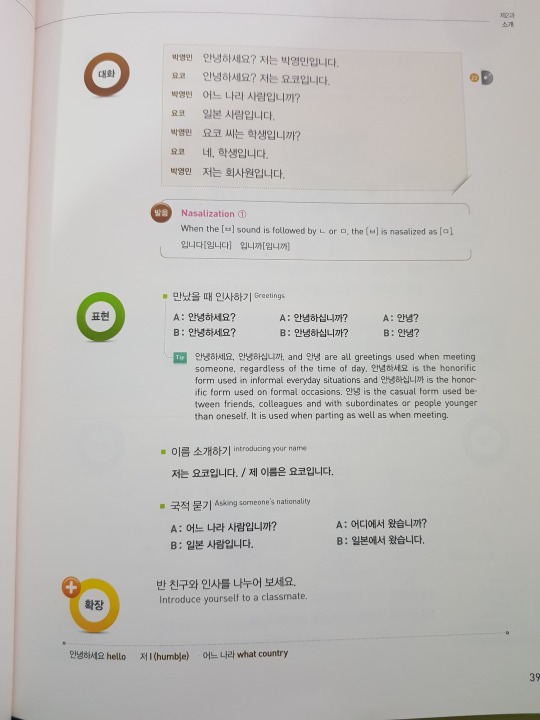
The prep lessons build up to a practice conversation! You get a little information about your roleplay characters and what you’re supposed to be talking about. Basically it’s guiding you and nudging you to use the grammar it’s just introduced to create a conversation. It tells you things like “make a greeting and introduce yourself” “ask their nationality” blah blah and you’re supposed to construct the conversation. On the next page they’ve written out the conversation how they want you to follow it, so don’t look! Cover it up as you try to do it so you don’t rely on just reading it. It’s a really beneficial way of learning to make sentences and especially to think outside of the box of what you’re used to!
As you can see on that page, sometimes they throw in pronunciation tips, which I definitely needed when I first started out! I was lucky I started with TTMIK who do a good job of explaining why ~습니다 is pronounced as ~슴니다 but other things I didn’t learn about until later.
They also give you conversational tips! Obviously you might not be able to figure out the conversation fully on your own, but the book has extras for you. It’s good to try your best and then to check the dialogue and see how or why they came up with what they did. I really like this part, because sometimes I get fixated on one way to say or express something, but as with all languages, there’s many ways to say things! I don’t know why I become so uncreative when I’m trying to construct things in Korean; I guess a sense of unfamiliarity where with English I know exactly how to throw things together. So these are parts are VERY IMPORTANT in really expanding your manner of speech and understanding!
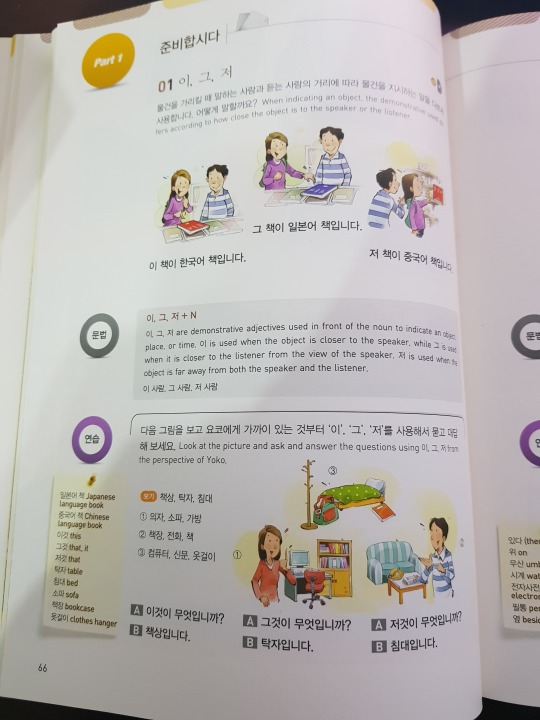
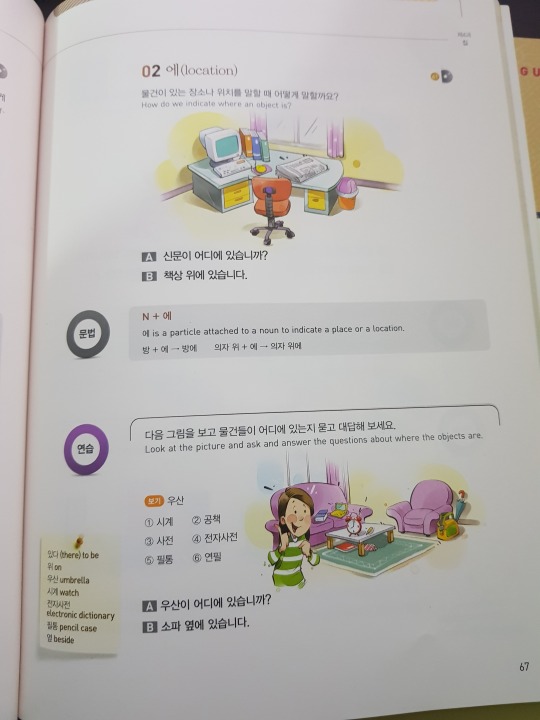
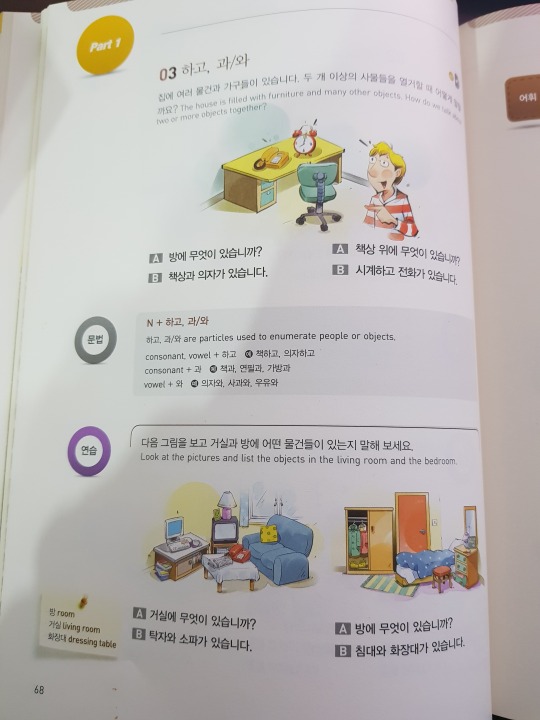
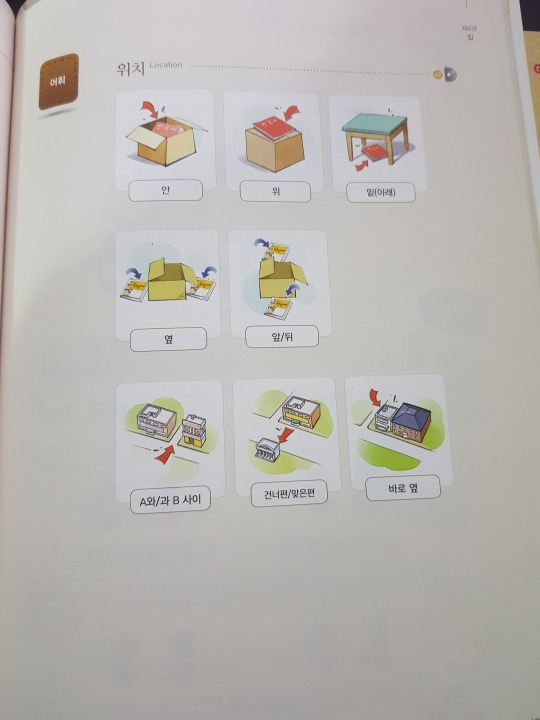
As you can see, it continues this way, following this sort of pattern of prep lessons leading up to a conversation practice. Occasionally, EWHA will throw in a page with images and what they are in Korean. Obviously, you’re supposed to figure out what they are visually but I’ll confess sometimes I’ve had issues with that, but don’t worry; the study guide has you covered! We’ll get to that soon, I promise.
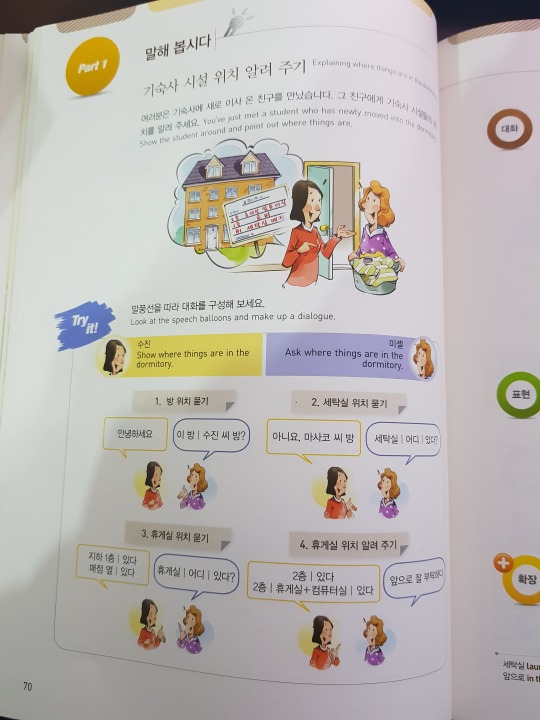
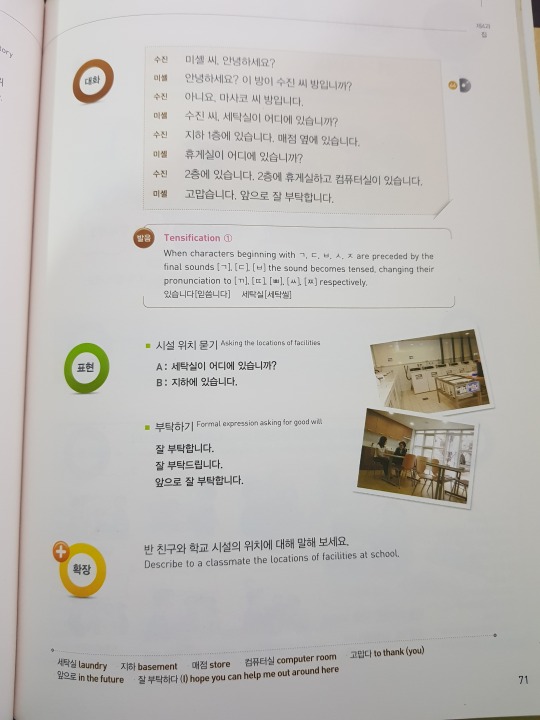
Another example of the conversation practice. Note there’s even MORE vocab at the bottom!
Towards the end of the lesson, there’s always an audio piece that you listen to and answer comprehension questions over and you get MORE fun little expressions like above, except these you’ll have to find in your study guide. It’s really important you get these as a set because if you don’t, you’re lacking an entire half of your EWHA experience - and the study guide just makes it better for self-learners.
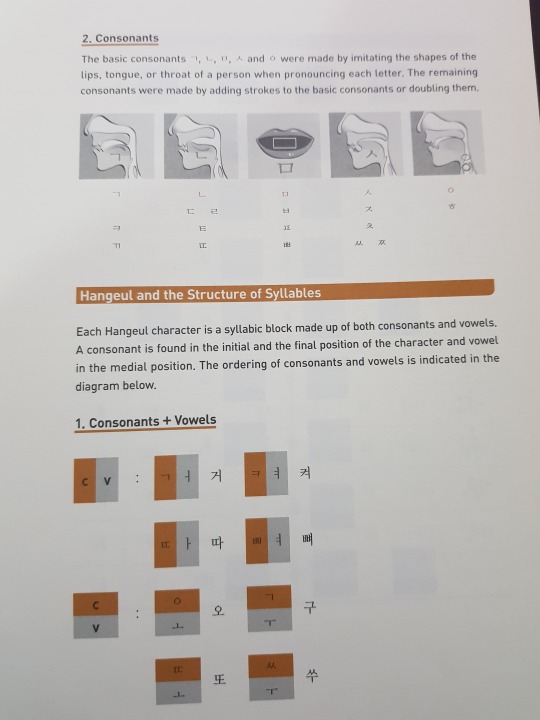
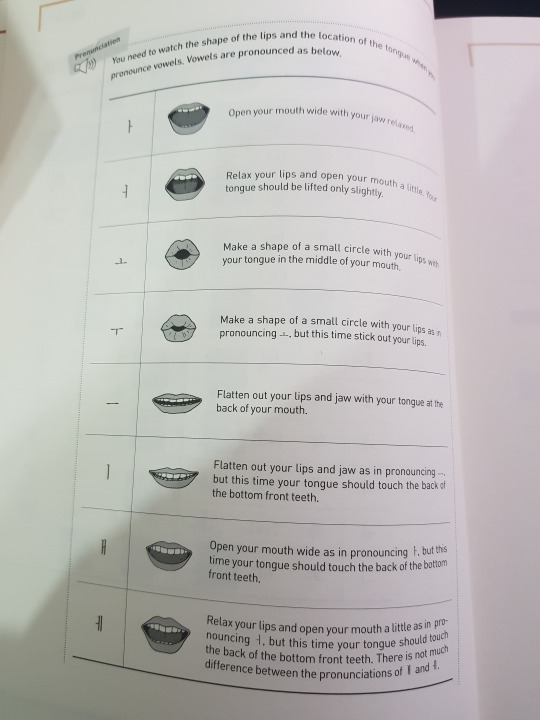
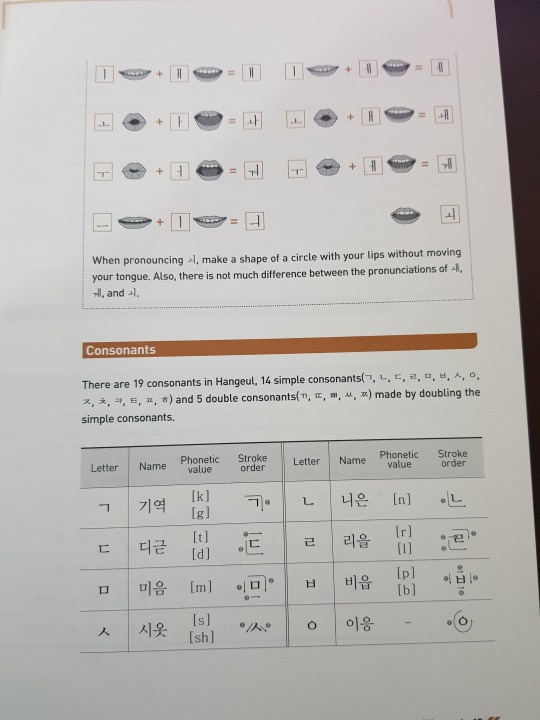
Like the textbook, it also opens with some pronunciation and intro to Hangeul type things. You really aren’t lacking for this kind of stuff, when it comes to these books! It’s also why I always recommend these to beginners! While I am fortunate to currently be in Korea where I can practice and have people help correct me, when I started out self-learning there was no one to do that and I was going off of (terrible) romantization to figure out how to say things. It was bad!
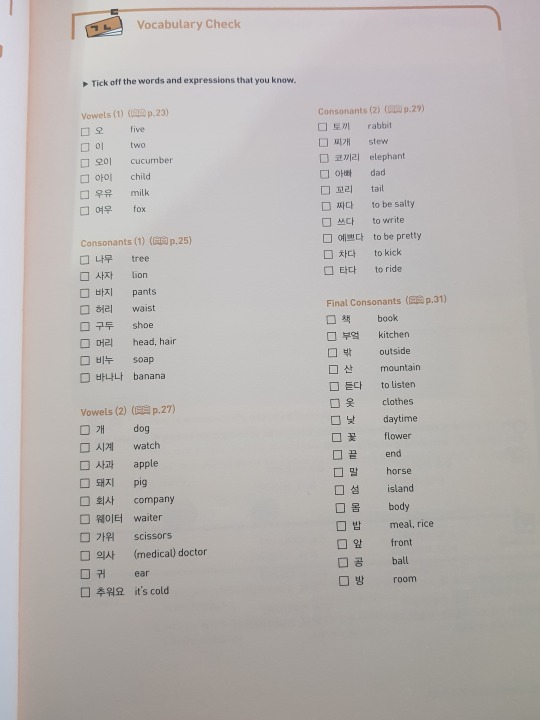
At the end of every lesson, the study guide has a vocabulary check and this! Is! One of my favorite! Things about the study guides!!!!! In the series 1 books it’s very often just words but as you get into series 2, you get phrases and the such which is useful because, again, sometimes I just forget how to construct things I know and it’s nice to see it used in ways that makes you go “ahhh” and helps you make better use.
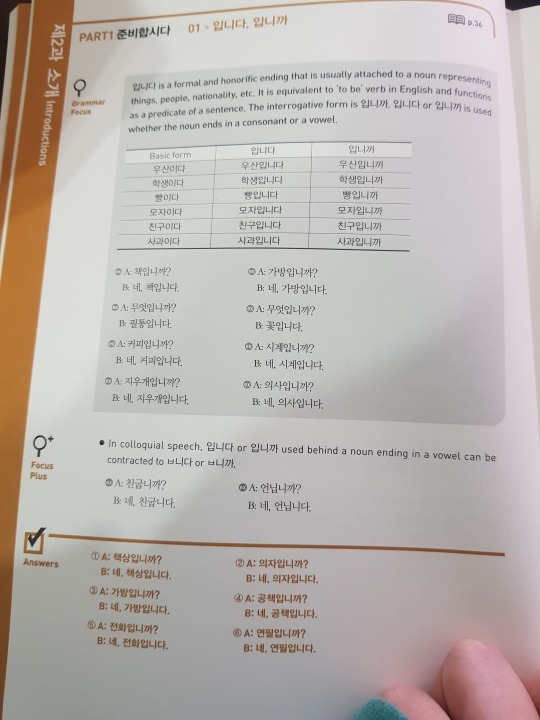
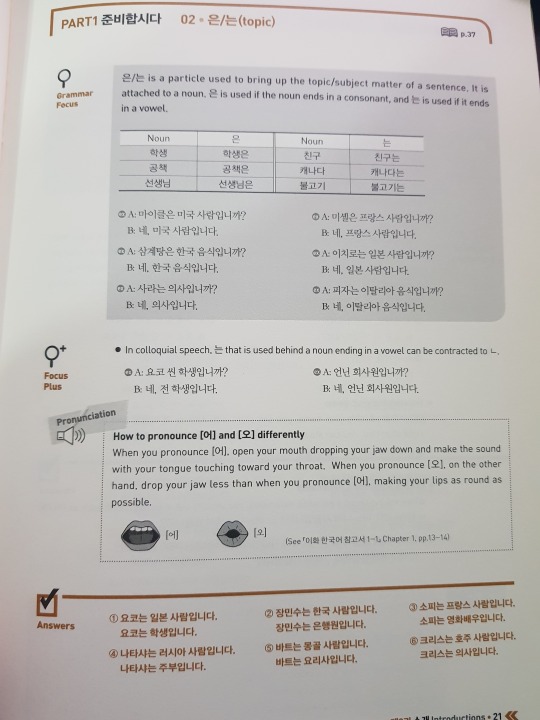
The study guide always shows which pages of the textbook it corresponds to. You can see how there’s a tiny bit of extra information in here; there’s not a lot at this point, because these things don’t necessarily need as much explanation - but there’s plenty of sample sentences! Read the sample sentences! If you’re having a hard time understanding something, reading the samples might be able to help you glean what you’re supposed to be understanding.
As you can see, there’s also an answer key to the activities in the book, which is really great if you don’t have anyone to check your work!
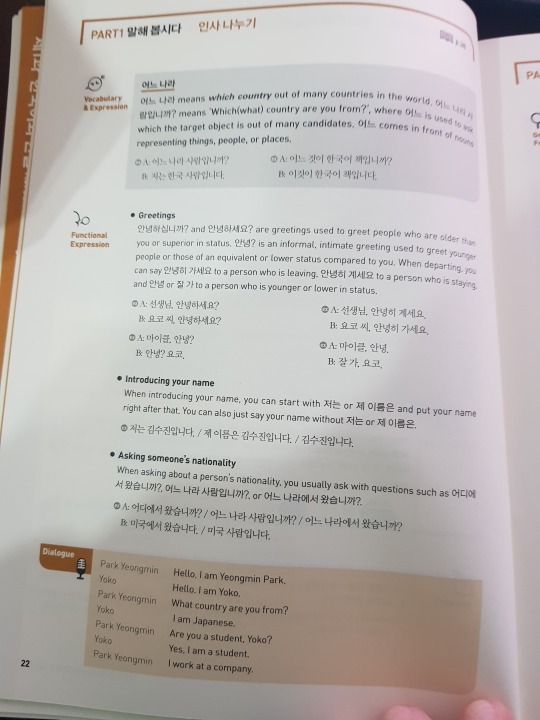
Remember those little expressions in the conversation practice pages? The study guide goes further into depth on them and helping you with your usage. This is the second best part of the study guide! It’s just really full of extras to help you out!
You can also find transcripts for the audio dialogues in here!
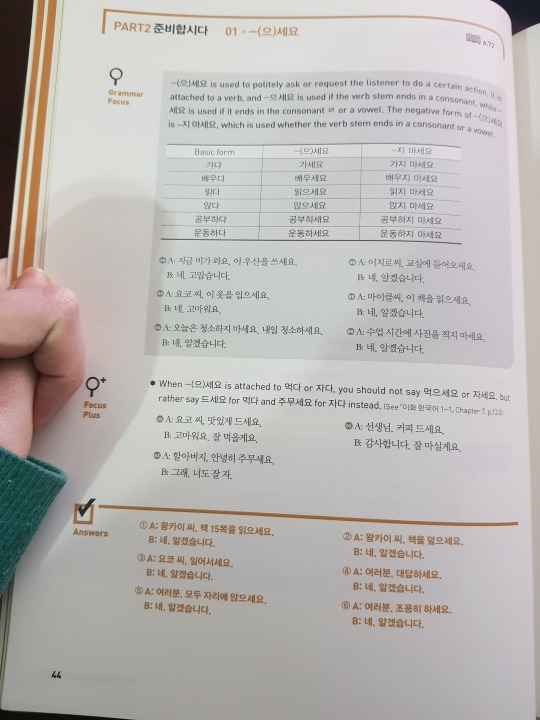
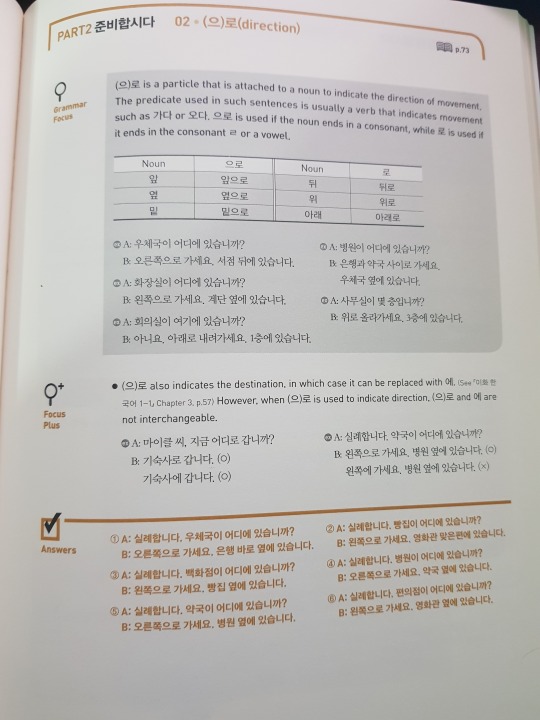
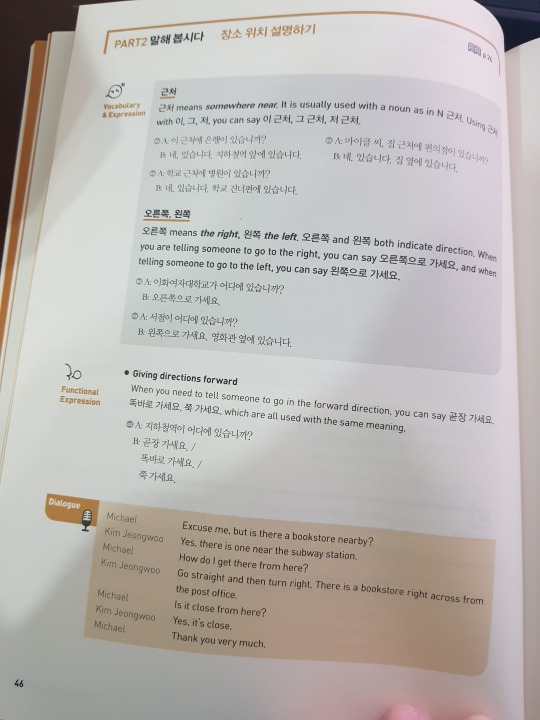
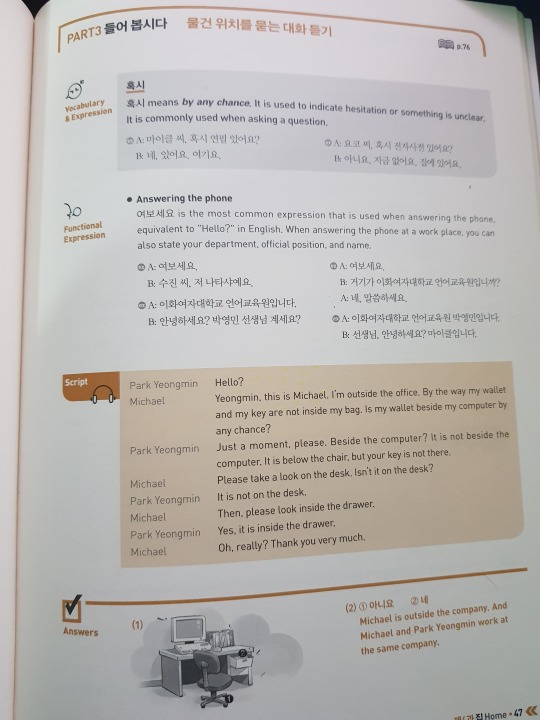
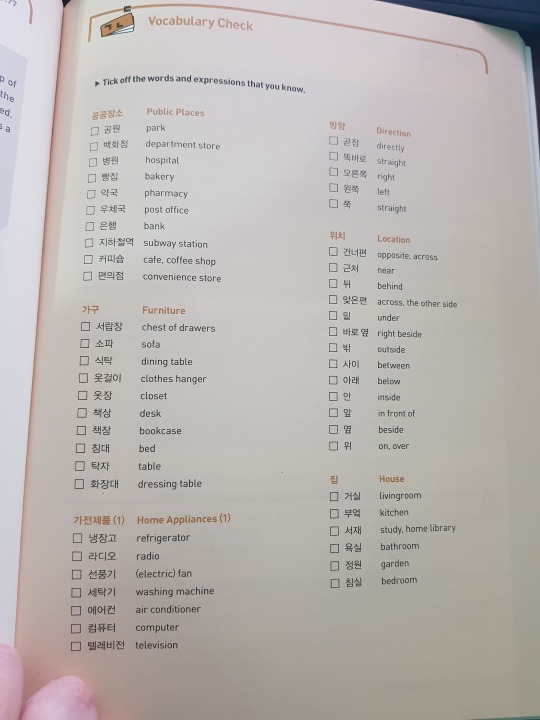
Just a few more samples!
Both sets are really wonderful for learning Korean. I maintain that the “best” one is whichever adheres best to your learning style. If you, like me, require lots of explanation, then Integrated might be best for you. It’s extra full of activities which really negates the need for a workbook. Unfortunately, you need someone to check your work, because while there’s translations for dialogue, there’s no answer key for your activities. EWHA is great for a self-studier in the manner that they DO provide not only transcripts/dialogue translations but also answer keys. Someone who doesn’t necessarily need things explicitly laid out can benefit from EWHA and to be honest, it could probably help people learn TO take meaning through context. Again, if you go with EWHA, you really need the Study Guides as well for the entire experience.
Some things: re EWHA. As you can see above, in books 1-1 and 1-2, your instructions and lesson introductions are written in both English and Korean. By series 2, the English there disappears. You still have English explanations and vocab translations, but your activity instructions and lesson intros are entirely Korean. By series 3, it’s FULL Korean. Your study guide still has English!!!! But your books? Korean! Even the vocab!!!!! I’ll try to remember to add pics of that later. But the idea is, of course, that you’ll learn as you go and eventually you won’t need it entirely written in English. I’m certainly not at that point yet, but I hope I’ll be able to get there soon!
Obviously, textbooks don’t come very cheap, so if you have to choose between the two sets, weigh your pros and cons. That said, the way I use them typically is that Integrated gets prioritized and then when I need a break or a review, I use EWHA. I used to review through Integrated but I find I’m not really taking in anything new when I’m just going over something I remember. By using both sets, I get different vocab sets, different situations, different kinds of usages of the grammar I’m learning. Both introduce things at different times. I’ve learned some things from EWHA that hadn’t been introduced to me at the time in Integrated where sometimes Integrated introduced to me things EWHA wouldn’t for a LONG time get to. But they both give me unique, fresh takes on things I’m learning. I’ve bought my books over a long period of time, so if you DO want to play with both, I’d say start with one set and later on down the line, add the other, so you can spread out the purchases.
Regardless, even if you can only choose one, I think they both have very strong merits as learning tools - and there’s always additional (free) options to help pad out your learning. I still make use of Talk to Me in Korean when I need to review something or I want another take on it or I need another explanation. When I REALLY want to get in-depth with things, I hit up How to Study Korean, where things are really broken down and in-detail explained. Don’t rely on just one study option. If you choose to use a textbook series, pad it out with the free online resources as well! The more ways you can see things used, the better it will stick with you!
I hope this is able to help a little! If you have questions, feel free to ask me! I can try to get some simple comparisons later of Integrated Intermediate level and EWHA series 3 books, and eventually I’ll do some write ups about the TTMIK books I own and the ways I find them useful!
12 notes
·
View notes
Text
Lessons from the Edit: Man of Steel
[UPDATE 8/27/2017: New, working video link below! Please note: to watch videos in their entirety, download the video to your computer. Streaming from Dropbox will only allow you to watch the first 60 minutes.] A Zack Snyder film is like that college freshman who got a little too into Ayn Rand his senior year of high school, has taken one Intro to Philosophy course, one Intro to Political Science course, and is now writing a manifesto. You know all of this because when he walked into your English class you said “Cool trench coat” and he mistook your derision for interest and now he won’t stop talking at you.
Zack Snyder’s films won’t stop talking at us and so, apparently, they’re here to stay. When I was a senior in high school, I defended Watchmen as a bold but fitting adaptation of a ground-breaking graphic novel. I thought it was very cool.
Now I’m just tired.
In this installment of Lessons from the Edit, we’ll take a look at Snyder’s first entry in the troubled and tone-deaf DCEU: Man of Steel.
I remember being very perplexed by the news that Christopher Nolan would produce (and, implicitly, oversee) a film directed by Zack Snyder. Nolan’s Dark Knight Trilogy felt like a fresh take on the superhero genre by treating it like a grounded, crime film. The Dark Knight clearly wants to be a Michael Mann film and blatantly steals from Heat. Zack Snyder has spent his career doing the exact opposite.
300 and Watchmen, whether or not you consider them successful or good, found interesting ways to translate the visual media of comic book graphics into audio-visual media of film without feeling derivative (see Ang Lee’s Hulk for that). A meeting of Nolan and Snyder’s worlds seemed incomprehensible. And it sort of was.
Man of Steel is like Michael Bay on downers. It’s still all American flags and muscle but the 2013 film feels like something Bay would make while on Xanax as opposed to (and I’m just speculating here) his usual cocaine. This is undoubtedly due in part to Snyder’s cinematographer, Amir Mokri, who book-ended his work on Man of Steel with two Transformers movies and was the DP for Bad Boys 2back in 2003.
Snyder trades in Bay’s kinetic maximalism for handheld wobbling in dialogue scenes and extraneous snap-zooms in CGI-heavy action scenes. If a Michael Bay film is a haywire roller-coaster, Man of Steel is like being in a small boat on choppy water. It’s a sea-sickness simulator. If the camera movement alone isn’t enough for you, Snyder kindly included plenty of teal/grey color grading so that everyone in the movie looks as sick as you feel.
The film’s look can probably be chalked up to Zack Snyder knowing he needed to depart from his previous, and now rather clichéd, style of inky blacks and time-ramping. So, credit where it’s due: at least Snyder was trying something – even if it was just extreme close-ups on farmhouse paraphernalia. That’s more than can be said for the aggressively bland visuals in the Marvel movies. Still, the direction in Man of Steel can be broken down into two basic parts: the boring first half and the migraine-inducing second half.
The one scene that I was pleasantly surprised by in preparing for my re-edit involved Russell Crowe’s Jor-El explaining to Clark where he came from and what happened to Krypton. It’s a simulated long-take wherein the camera glides from Crowe to Cavill to the graphite-colored bas-relief sculptures that are interesting enough to look at, if a bit cartoony. This brief moment has fluidity and rhythm and feels purposeful even though it’s all exposition that, in the theatrical cut, the audience already knows because they saw it in the beginning of the movie.
In an earlier scene, Clark is talking to his Earthly father, Jonathan Kent, at an old pickup truck in another relatively long take but here it is understandable why the first half of the film just seems to drag: nothing is happening. We linger on scenes of Pa Kent doggedly trying to convince his son not to become the superhero we all know he will be. These scenes could have been used to build up an actual relationship between young Clark and his dad so that Jonathan’s eventual death might mean something to us. Because here it doesn’t. These characters don’t feel like they have inner lives – they're clunky conduits for haughty monologues.
Despite the fact that none of the characters are compelling or three-dimensional, the cast is full of highly talented actors who all seem to be trying their best. And also Henry Cavill. Amy Adams, Michael Shannon, Laurence Fishburne, Kevin Costner, Diane Lane, Russell Crowe – they’re all perfect for their roles, in theory, but they’re reduced to doling out lame speeches and hacky expositional dialogue. Whenever Amy Adams does a damsel-in-distress style scream I feel embarrassed. I’m embarrassed for Adams, who is wasting her time filming this trash, and for all the people who inexplicably think this is a quality film.
Henry Cavill is not good in this movie. Let me rephrase: of all the terrible lines by all the uninteresting characters in this movie, Henry Cavill’s are the least convincingly acted and he is the least interesting performer to watch. Let me rephrase: why was Henry Cavill cast in this movie? Is it because he’s buff? Because basically anyone could be buff if they trained (I’ve always felt that Superman doesn’t really need to have a bodybuilder’s physique anyway, but I don’t want to get into that right now).
If it were up to me, Superman would be played by James Wolk. In his role as Bob Benson on Mad Men, Wolk is the kind-hearted, loyal boy-scout that a superman should be. He has a combination of warmth and strength that doesn’t have to be cheesy or campy if you write it well enough. But there are plenty of people who could play Superman. There are plenty of people who can act. Henry Cavill is not one of them.
Also, whoever did his wardrobe should be fired. Granted, Henry Cavill looks good in the Superman suit but in the scene where Lois meets Clark in the cemetery it looks like Clark has never worn clothes before. Like, his pants and shirt are super baggy and he’s wearing a baseball cap really awkwardly. I guess it’s a “disguise?” Or they were trying to hide how muscular he is? Whatever, I’m getting off topic.
The craziest thing about Man of Steel is that it’s better than Batman V Superman. In Man of Steel, it’s at least clear why characters are doing what they’re doing. The story is pretty simple and character motivations are relatively logical within the context of the film. That’s much more than can be said for BVS. Because, in short, no: a movie is not good just because “Batman had a scene where he was cool in it.” You’re a child. That’s a bad argument.
More importantly, watch BVSand then watch Man of Steel again and try to tell me it isn’t the most blatant invocation of retroactive continuity you’ve ever seen. The last shot of Man of Steel is Clark Kent smiling.
Let me repeat: the last shot of Man of Steel is Clark Kent smiling.
At the time, it felt incredibly tone-deaf that the last scene was so chipper after we just witnessed an hour of cataclysmic destruction but now it just feels strangely quaint and innocent. It seems pretty clear that “Superman Goes to Court” was not the original plan for a Man of Steel sequel and was only a result of the outcry against the gratuitous destruction.
The main impetus for my edit of Man of Steel was the removal of all of that mind-numbing “action” where the characters turn into rubber and Zack Snyder gives up on composing interesting, or even discernible, shots. Furthermore, nothing is learned from these scenes other than plot points to be checked off. Superman doesn’t grow or change throughout the course of the fight and Zod is as hell-bent on his dastardly plan in the end as he was in the beginning. In reading the comments on my Rogue One edit I learned that some people just don’t care about character development. That’s insane to me but it also completely explains the current state of big-budget cinema and why people like something so insultingly dumb.
My other goal, and the most time consuming element, for this edit was fixing the color. Snyder shot Man of Steel on film. There’s a richness and a texture buried underneath all the bland, sickly desaturation that the Marvel movies will never achieve with their cheap, digital shooting. Lots of people have re-saturated the “Superman Flight” scene on YouTube – I tried to carry that through the whole movie and, honestly, I may have overdone it in a few places.
So here it is, Superman: a Chris on Cinema edit: https://www.dropbox.com/s/al3u8hynubs6jdy/SupermanMOS.mp4?dl=0 (NOTE: You need to have one of Dropbox's paid accounts to stream more than the first hour of the video but you should be able to download the video in its entirety. I'm currently trying to find a better streaming platform.)
Let me know what you think! Not really about Man of Steel (I’m sick of even looking at the film at this point) but about my edit in relation to it. So sound off: is it better? Is it worse? Would you like to hear a commentary track where I go into more detail about everything I cut? What’s another flawed or good-but-frustratingly-not-great movie that you’d like to see an edit of?
Next time on Lessons from the Edit: a movie that didn’t really need my help in the first place.
Before you download “Superman” please pay for a copy of the original film. “Man of Steel” is a Syncopy Production presented by Warner Bros. Pictures in association with Legendary Pictures. Directed by Zack Snyder with music by Hans Zimmer. Based upon “Superman” characters created by Jerry Siegel and Joe Shuster published by DC Entertainment.
@chrison_
0 notes
Text
some comprehensible input links
language learning forums can be so toxic sometimes...
so many people love to push that “one method” is phenomenal and works when others just WON’T, meanwhile another will say the opposite. And then its like... where is the room to acknowledge maybe parts of each method have merit for different individuals, since they might help or click in different ways.
just today i saw someone arguing about stephen krashen’s language theories and how they’re all disproven bullshit that are completely unusable. I don’t know a huge amount about his theories. But I do know the emphasis he brought up on “providing students comprehensible input and lessons to learn from” is a concept that also is in stuff like the modern Teach Languages Through Storytelling lessons and Comprehensible Input Lessons. Which if you’ve ever used them? They’re Amazing. They are lessons where teachers purposefully use the target language as much as possible, and use visuals to help make what they say as comprehensible as possible to students so they can learn. This is how when I volunteered, we were supposed to tutor ESL speakers - because we could not reliably teach with english translation since their english levels varied, and we did not have speakers of every learners native language present to help teach them. Our program coordinator showed an example of how to do it by teaching us some Thai, his native language, in this method. And it was extremely easy to follow and understand. Textbooks/grammar guides/flashcards certainly will help speed up the process - aka allow students to use Graded Reader books, learner podcasts, then target language native materials like shows and novels to learn quicker. But lessons in the target language as soon as possible, emphazising getting students to comprehend, is valuable. Just as its valuable later on when students can handle more complex lessons in the target language.
Examples of teachers teaching through comprehensible input (I am thrilled to notice there’s a lot more than last time I looked these sorts of channels up):
Hit Chinese: https://youtu.be/xG3w2i1OBfc
Unconventional Chinese with Keren: https://youtu.be/9N-nNvnAYTs
French Comprehensible Input: https://youtu.be/c2SUQVjklVA
Alice Ayel (french): https://youtu.be/DcuVNAnsWZM
Dreaming Spanish (a fantastic example): https://youtu.be/ObO1CGY_NHI
Comprehensible Russian: https://youtu.be/gHCvEKxeXvk
Comprehensible Japanese: https://youtu.be/gHCvEKxeXvk
Japanese Immersion with Asami: https://youtu.be/pr_yRUVQQt0
Learn Korean in Korean*: https://youtu.be/zUulbCruiMs
I just found the Learn Korean in Korean channel a few weeks ago, notable in that he also teaches hangul before the other lessons. I think he maybe uses too few pictures to make it as easy on students. But having said that, I know zero korean whatsoever and am watching his Lesson 1 and finding it completely easy to follow. So I’d say yes his teaching style probably falls under “engage student in the target language and make it comprehensible so they can learn it.” I’m really impressed with his channel tbh because it teaches totally in Korean so any language learner from any native language could use it.
Just found Japanese Immersion with Asami today while looking up “japanese comprehensible input” and its an amazing example of how these kinds of lessons work. In a classroom setting (or with a tutor), generally the idea is to provide learners with lots of comprehensible input of the language they’re learning and perhaps some help to keep things comprehensible (in a classroom that would be word definitions on the board maybe for reference, or in these examples subtitles to aid learners for reference - although first priority a teacher is aiming to use pictures/gestures/visuals to make as much as possible comprehensible).
Examples of textbooks that teach through comprehensible input (these were made before Krashen, so i merely bring up Krashen because Today’s Language Forum Arguement was ‘all krashen’s ideas are bullshit ALL of them even comprehensible input ideas so you shouldn’t even bother using even a little of something related to his ideas):
French: https://archive.org/details/jensen-arthur-le-francais-par-la-methode-nature
Italian: https://archive.org/details/LitalianoSecondoIlMetodoNatura
Latin: lingva latina per se illustrata
English: https://archive.org/details/english-by-the-nature-method
(I’ve personally used that textbook for french and absolutely loved its teaching style, it works Really Well for me).
Graded readers, if they teach new vocabulary in context, may also fall into this section (depending on learner’s starting level compared to a graded reader).
my only point here is just. i hate seeing valuable learning methods completely thrown away, just because someone’s decided to equate one person’s specific method as bad - to decide every single thing related to it must be useless. In this particular case - before Krashen was old enough to have any theories, Arthur Jensen was making some of those books listed above! (Back then it was called ‘the nature method’ - although plenty of books using the term ‘the nature method’ do not teach as comprehensibly as what I’ve listed above, there’s definitely a range from ‘these are just vocab lists’ to ‘these are actually slowly teaching me new words in context’ lol). and all those youtube channels for comprehensible input? There are learners who do find them useful! I’ve found them useful!
oh man just today... sometimes people will be like “you MUST use flashcards to learn a language” and hello no you absolutely don’t have to i never did with French. Some people say “you MUST use textbooks” and yet there’s examples of people who did fine without them, vice versa people say “you must NOT use textbooks if you want to sound natural’ or whatever which? Me using grammar guides has always been immensely useful for me personally - though again some people found success with Much more textbook use, and with none. So can we please accept different methods work for different people?! And beyond that - maybe some Pieces of methods are useful to someone EVEN if the ‘whole thing’ isn’t.
Mass Immersion Method/Refold - its not ‘all’ for me. I’m never ever going to sentence mine. I rarely use flashcards and I never plant to MAKE any myself lol. Have I still found some useful pieces of Refold that have benefited me? YES I have. (Notably the parts about ‘comprehensible input’ since we’re on the topic). What I took from what little i have heard from Krashen - in particular a lecture he gave on improving reading ability in students - is reading for pleasure, exposing yourself to a lot of material even if its not perfectly at your level, will help you improve. Students who learned word lists, and students encouraged to extensively read, both made vocabulary and reading level improvements. Which - we’ve been in elementary school and had ‘free reading time’ to help us learn to read better! By reading something we liked for a period of time! Besides just the books assigned in class the teacher had us do vocab lists for! Well, in my french studies I very much saw that apply to my own second language learning too - sometimes I looked up words as I read, and learned words that way. Sometimes I simply read french for pleasure and just guessed at unknown words I Could guess at and moved past others - and also improved my reading ability and picked up some new words. Both ways helped my french improve, my reading improve, my vocab improve. And so that is what I took from it - that there is some merit in engaging with something you can understand Somewhat at least. That if you have some comprehension of a material, you may be able to learn Some More from it whether you just learn from context OR conciously look up everything unfamiliar. (And I do think looking things up speeds up the process sometimes). My point though is like... we’re really gonna throw out some good pieces because we don’t like one person who’s managed to touch on them? When so many before and after, their own levels of correct and useless parts, have found some usefulness in some parts?
I just do not get language forum drama lol... the issue is. These people were arguing because they find krashen ‘useless’ then all comprehensible input study is ‘useless’. Ok then. But pushing to all learners to use only a textbook, and avoid engaging with actual language (even when it may be comprehensible and therefore useful to them like the links above, for some learners), then they may slow their progress if it doesn’t suit them well. And it always depends on the individual, everyone’s a bit different.
#reference#resources#comprehensible input#rant#half of this is a rant at how all or ntohing some learner forums can be feel free to ignore it#i just. so many ppl shoot themselves in the foot#cause theyd rather shit on other things and say their own plan is perfect#than consider maybe. people have different unique needs/ways of doing things#ive never found a method that 100% worked for me?#but i found lots of Pieces of mutliplte ones that did!
71 notes
·
View notes